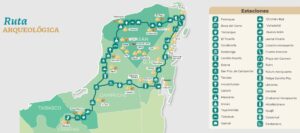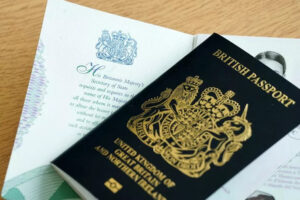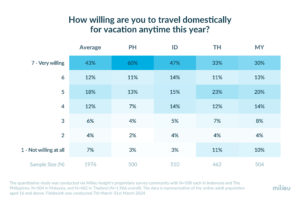The Ultimate Albania Road Trip Itinerary – 2 Weeks in Albania
38 min readLooking to check-off all the Albania must-sees and still venture off the tourist trail? My alternative Albania road trip itinerary...
Looking to check-off all the Albania must-sees and still venture off the tourist trail? My alternative Albania road trip itinerary offers a perfect balance of essential and offbeat destinations over two action-packed weeks.
With affordable rentals, excellent roads and an infinite supply of awe-inspiring landscapes, picturesque villages and dynamic cities, Albania is made for a self-driving adventure.
Driving around Albania this past autumn will go down in history as one of my favourite travel experiences of all time.
Having visited Albania for the first time a few years prior and exclusively relying on public transport, I am in a unique position to compare the two experiences. I can wholeheartedly assure you that renting a car in Albania is 100% worth it – particularly if you are travelling in the shoulder or low season.
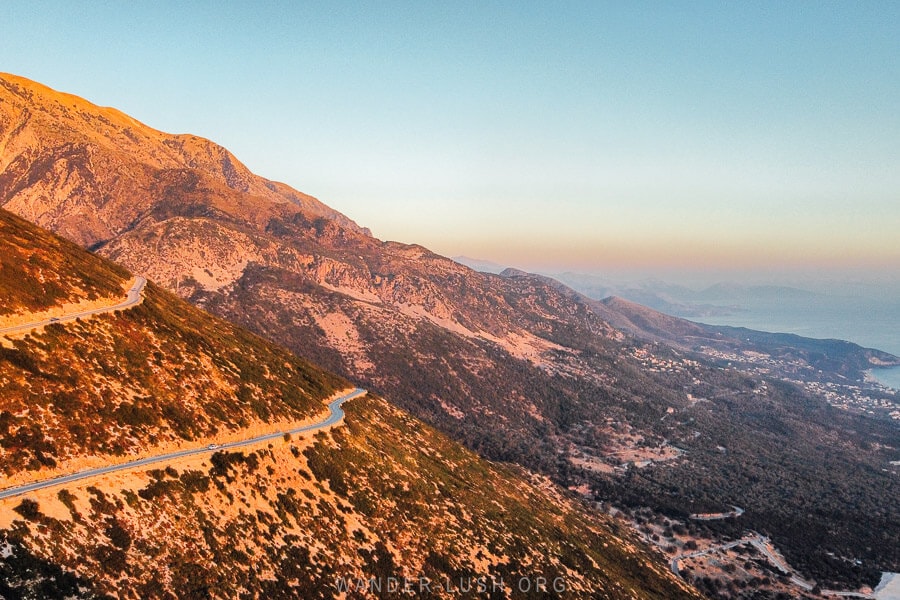
While most Albania road trip itineraries focus on the Adriatic Coast, my route ventures to underrated and lesser-travelled parts of the country, including along the Vjosa River Valley and Lake Ohrid.
A tidy loop starting and finishing in the capital, Tirana, it covers all the must-sees in central-south Albania including Berat, Himara and Gjirokaster. It travels two of the country’s most scenic stretches of road, the coastal Llogara Pass and the newly sealed road from Permet to Korca, and includes ample opportunities for adventurous detours.
For all things parking, petrol and other practicalities, see my tips for driving in Albania (coming soon).
Please note: This post contains affiliate links, meaning I may earn a commission if you make a purchase by clicking a link (at no extra cost to you). Learn more.
Transparency: Our car rental was sponsored by my long-term partners at Local Rent. All other expenses incurred during our trip were covered by us. I am solely responsible for creating this itinerary without any external input. All recommendations/criticisms are 100% my own.
Places visited on this Albania itinerary
Here is a quick summary of the main destinations on my 2-week itinerary. As you will soon see, there is a whole lot more to see and do between the major stops.
- Tirana — Albania’s fast-evolving capital city.
- Berat & Gjirokaster — twin UNESCO cities in Albania’s lush interior.
- The Albanian Riviera — beaches, canyons & a scenic drive down the Llogara Pass.
- Dhermi, Vuno & Upper Qeparo — charming Albanian villages hidden in the hills behind the beach.
- The Blue Eye — the famous natural pool between Ksamil and Gjirokaster.
- Benja & Sarandaporo — thermal springs in southeastern Albania.
- The Vjosa River — Europe’s last wild river.
- Permet — Albania’s capital of ecotourism & slow food.
- Leskovik — a hidden gem in the wine region & one of Albania’s best boutique accommodations.
- Lin — the oldest village in Europe on the Albanian side of Lake Ohrid.
- Korca — an underrated small city near the Greek border.
- Voskopoja — a village brimming with Byzantine churches.
- Butrint National Park & Apollonia — two of Albania’s premier archaeological sites.
Albania road trip route overview & map
This tried-and-tested driving route is essentially an exact replica of the road trip Ross and I did this autumn (with a few minor adjustments). It is well-paced, with only a couple of big driving days and plenty of down-time.
- Day 0: Arrive in Tirana – stay in Tirana at Konak I Skanderbeg Square
- Day 1: Lunch at Fustanella Farm – drive to Berat – stay in Berat at Josiph B&B
- Day 2: Full day in Berat & Osumi Canyon – stay at Josiph B&B
- Day 3: Visit Apollonia, Fier, Vlora & the Zvernec Islands – drive the Llogara Pass – stay in Dhermi at Roots
- Day 4: Full day in Dhermi – stay at Roots
- Day 5: Visit Vuno, Himara & Porto Palermo Castle – continue to Upper Qeparo – stay in Upper Qeparo at Villa Porta
- Day 6: Visit Saranda, Butrint NP, the Blue Eye & Field of Bunkers – stay in Gjirokaster at Jani Studio Apartments
- Day 7: Full day in Gjirokaster – stay at Jani Studio Apartments
- Day 8: Visit Tepelena & Ali Pasha’s Aqueduct – continue to Permet – walk to Leus – stay in Permet at Villa Permet or in Leus at Chri Chri Guest House
- Day 9: Visit the Benja Thermal Springs – return to Permet – stay at Villa Permet
- Day 10: Visit the Sarandaporo Thermal Springs – continue to Leskovik – stay in Leskovik at the Melesin Distillery
- Day 11: Visit Voskopoja – continue to Korca – stay in Korca at Villa Domenico or in Voskopoja at Stone Villas
- Day 12: Full day in Korca – stay at Villa Domenico
- Day 13: Visit Pogradec & the Royal Tombs of Selca – continue to Lin – stay in Lin at House 1960
- Day 14: Return to Tirana – stay in Tirana at Konak I Skanderbeg Square
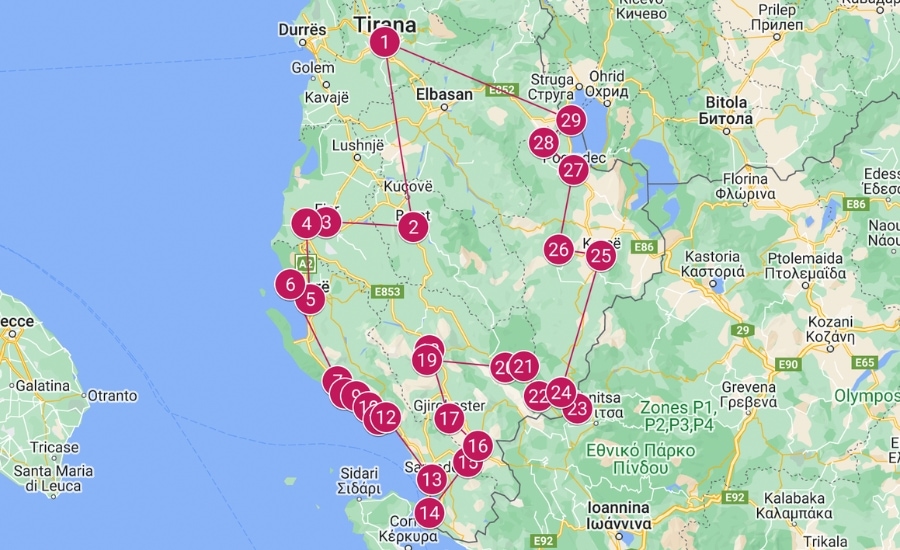
How long should you spend in Tirana?
Most travellers will arrive in Albania via Tirana, where one of the country’s two international airports is located. While I have budgeted for 2 days in Tirana, you might need to add on some additional time in the capital depending on your arrival/departure schedule. I recommend doing this at the top of the itinerary.
We had enough time to spend four full days in Tirana before hitting the road. Most travellers will find 48 hours is ample time for the highlights.
You definitely do not need or want to drive in Tirana. The small spurts of city driving we did were by far the most stressful moments of our trip. Most of the city is walkable, while you can easily get to further-flung spots including Dajti Mountain and Bunk’Art using the excellent city bus network.
What about Theth, Valbona and Shkoder?
You will notice there is one glaring omission from this itinerary: the north.
The Accursed Mountains and particularly the hike from Valbona to Theth is definitely one of the highlights of Albania – and I do suggest you make time for it. Having previously visited the Alps and completed the hike in 2019, I felt no desire to go back and repeat it out of season.
My decision to leave Shkoder, Valbona and Theth out of this road trip itinerary is actually quite deliberate. You do not want to drive to these places. The windy roads in the north are the worst in the country, and a car can be a liability in the mountains.
Because Valbona-Theth is a thru trek, planning a driving route around it is very clunky. Some people choose to drive to Theth, hike to Valbona, then walk back to the car the following day. But this means skipping the Komani Lake Ferry, which is a huge mistake in my opinion. And do you really want to repeat the same hike on back to back days?
Provided it’s the right season for trekking (May to October most years, weather depending), add an additional 4-5 days for the north of Albania. It will look something like this (this is the exact plan Ross and I followed back in 2019):
- Day 1: Furgon from Tirana to Shkoder – afternoon in Shkoder – stay in Shkoder at Sweet Living Apartment
- Day 2: Transfer to Fierze – Komani Lake Ferry – afternoon in Valbona – stay in Valbona at Guesthouse Mehmeti
- Day 3: Hike to Theth – stay in Theth at Guesthouse Marashi
- Day 4 (optional): Extra day in Theth for hiking & the Blue Eye – stay in Theth at Guesthouse Marashi
- Day 5: Furgon from Theth to Tirana – afternoon in Tirana – stay in Tirana
Another option is to: 1. Drive to Shkoder from Tirana (stopping in Kruje on the way); 2. Organise to leave your car at your guesthouse; 3. Take the Komani Ferry to Valbona; 4. Do the one-way hike; 5. Return to Shkoder by bus from Theth to pick up your car. This would mean leaving your car idle for 3-4 days, which is a bit of a waste in my mind.
It is possible to take a car on the ferry, but spots are limited and from what I understand, it can be a stressful process. And again, you would have to repeat the hike twice.
The Tirana-Shkoder-Valbona-Theth route is very popular and easy to do with public transport by booking a combination bus-ferry ticket online via the official Berisha page.
Need more time on the coast?
If you are a regular reader of this blog, you will know that I am not a beach person. Growing up in Queensland either spoiled me or scarred me – or perhaps a bit of both.
I am entirely unfamiliar with Eastern European beaches (outside of Georgia and the Black Sea Coast), so when we landed on the Albanian Riviera, I was quite taken aback by the huge developments and amount of trash that’s around. This might be controversial, but I just don’t think the beaches in Albania are all that appealing.
If you do want more time on the beach, then I would recommend adding a night in Himara or Saranda between Qeparo and Gjirokaster. For a good range of restaurants and non-beach activities, Saranda would be my top choice. Parking is a bit tricky in Saranda, so be sure to choose a hotel or guesthouse with onsite parking.
What is the best time of year for an Albanian driving holiday?
Albania’s tourism star is rising, and I expect it will only get more popular in the years to come. Having visited in June/July the first time around and experienced the summer crowds, this time we chose the month of October for our road trip. It turned out to be a very wise decision.
It was still warm enough to swim, Tirana was quiet, and in the interior of the country, conditions were perfect for spending long periods outdoors.
Shoulder season (autumn or spring) is by far the best time of year for a road trip in Albania. We were able to get a great price on our rental car, had stress-free parking everywhere (including on the beaches and in all cities), and the roads were far less busy compared to summer.
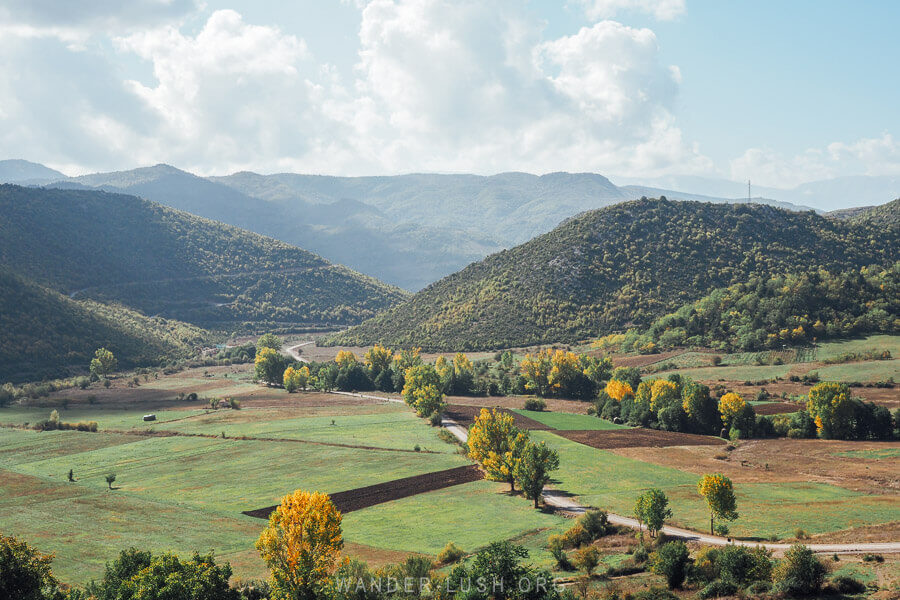
One thing to consider is that the coast shuts down in the off-season. Restaurants and bars along the beach are mostly closed. On a few occasions we experienced zombie apocalypse scenes on the Riviera, where deserted bars still had liquor bottles and glasses set on the bar – as if everyone had picked up and left in a hurry.
Visiting smaller villages requires a bit more pre-planning and flexibility, as many businesses and services shut down after September. In October, we found all the accommodations we had earmarked were still accepting guests – but by November, many had closed off bookings for the year.
If you plan to add the north of Albania to your itinerary, note that the Komani Lake Ferry only runs in summer.
Where to rent a car in Albania
We used Local Rent to find our Ford Fiesta. I regularly use this platform to hire cars in Georgia, and in Albania, it was a similarly smooth process.
Local Rent differs from larger companies in that it sources cars from local agents. Prices are generally much lower – from 14 Euro a day in Albania. In October, our car cost 375 Euro for 2 weeks.
While all major agencies in Albania require a credit card in the driver’s name, Local Rent does not. (No credit card was great news for us since we don’t have one.) There is no cash deposit required either – the only thing you pay in advance is a small online booking fee, which is refundable. The balance is settled in cash when you pick up the car.
Provided your licence meets the requirements, Local Rent agents in Albania do not require an International Driving Permit. All you need is your driving licence and ID (passport). Rules change, so for peace of mind I recommend contacting your agent in advance and asking them directly if they need an IDP.
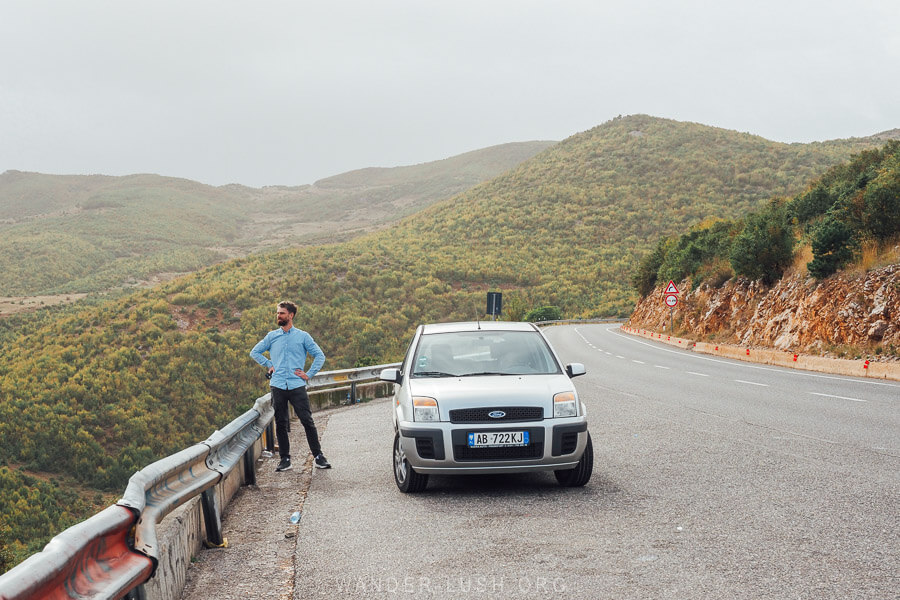
Local Rent has a nice fleet of cars in Albania (including plenty of auto transmission options). Our small car did the job just fine, but it definitely struggled on some of the steeper roads.
You do not need a 4WD for this itinerary, but it’s not a bad idea to upgrade to a 4WD or SUV. In retrospect, I should have gone with a more robust car to tackle those hills and unexpected unpaved sections. I am still shocked that we didn’t get a single flat tire.
Use my affiliate link to search for a rental car in Albania via Local Rent.
5 quick tips for driving in Albania
1. Drive with dipped headlights at all times — Just like in Montenegro, it’s the law. This quirk definitely takes some getting used to. If you are driving an older car, my advice is to set a lights-off routine from day one to avoid a flat battery disaster.
2. Use Google Maps to navigate — Save for a few very minor glitches (mostly where new highways and bypasses had not yet been mapped), Google Maps never let us down. Pick up a local SIM card in Tirana before you set off. We had good coverage with Vodafone.
3. Don’t worry about tolls or vignettes — There is only one toll road in Albania on the A1 highway between Durres and Kosovo. Since you are not likely to be driving this way (my road trip itinerary doesn’t venture in this direction), you do not need to worry about tolls, vignettes or other permits provided you stay within Albania.
4. Carry cash for fuel & parking — Free street parking is plentiful in smaller cities and villages (especially in the shoulder/off season), but you will need cash to pay for parking in some cities and beach towns. The only place where we needed to pay for street parking was Korca. Most petrol stations are old-school and work on a cash basis. Regular gas goes by the name ‘Benzine’. Stay in the car; the attendant will do the pumping for you.
5. Relax! — For the most part, driving in Albania is an enjoyable experience. 99% of the roads we encountered were in good condition, and the local driving style is quite laid back.
The perfect 2-week Albania road trip: Detailed day-by-day itinerary
This route mostly follows state highways (SH) with a few backroad detours. As mentioned, all the major roads we drove were in near perfect condition with the exception of the road from Leskovic to Korce, which is unfinished in one section.
Approximate drive times for each leg are included in parenthesis.
This turned out to be a long post, so I have only included a couple of images for each stop. You can find plenty more photos along with detailed descriptions in my separate destination guides, linked throughout.
Day 0: Arrive in Tirana
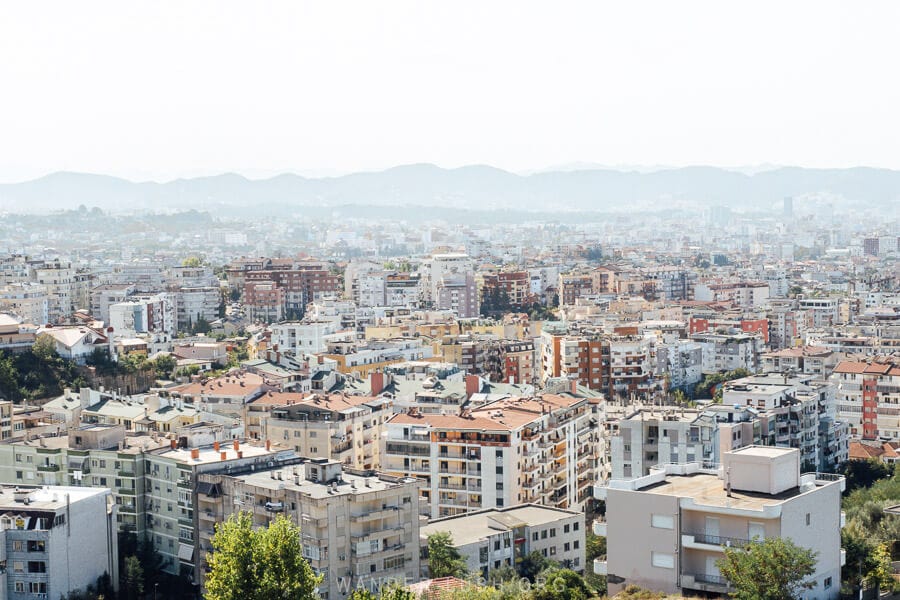
If you’re flying into Albania, note that Tirana Airport is 30-45 minutes from the city centre. The easiest and most affordable way to get in from the airport is by using the shuttle bus. It departs every hour, on the hour, 24-7. Tickets cost 400 LEK per person and can be purchased using cash (LEK or Euro) on board. Find the full details here in my Tirana Airport arrivals guide.
Tirana Airport is small and self-explanatory. There are both ATMs and cash exchange booths inside the arrivals hall. I recommend withdrawing a small amount of local currency when you arrive, then finding an ATM in the centre that has lower fees (the cheapest we could find was the American Bank of Investment, which charges a fee of 500 LEK).
You will definitely need a local SIM card for navigating the roads in Albania. We chose Vodafone – even though the customer service was lacklustre, the price was satisfactory and coverage was good throughout our trip. We paid 2,000 LEK for 30 GB of data (valid for 30 days) plus an additional 200 LEK for the SIM. We bought ours in-store but prices at the airport appeared to be the same. Browse all packages here.
Depending on your flight schedule, you might have a full day or an evening in Tirana. I suggest spending it in the city centre, seeing the mandatory sights on Skanderbeg Square then crossing the river to the Blloku neighbourhood.
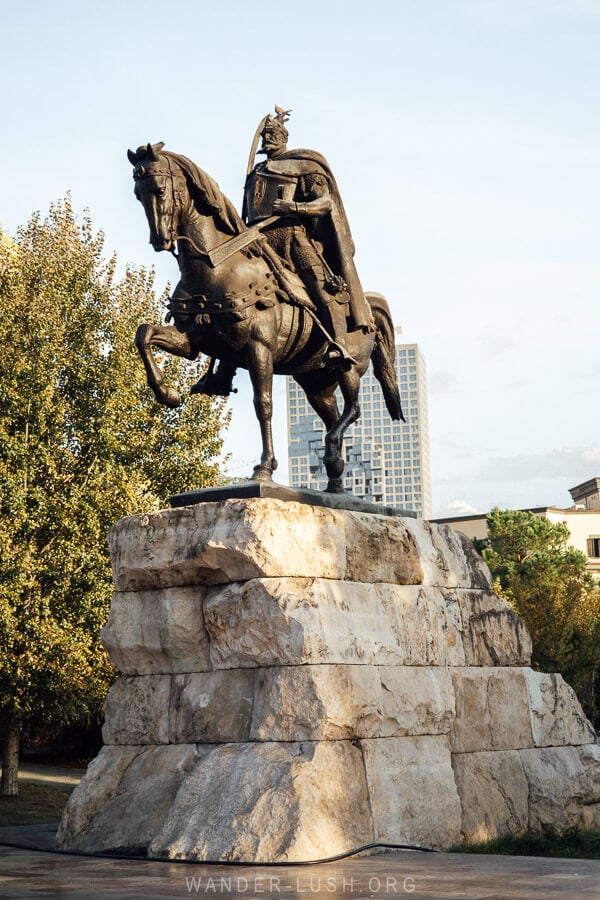
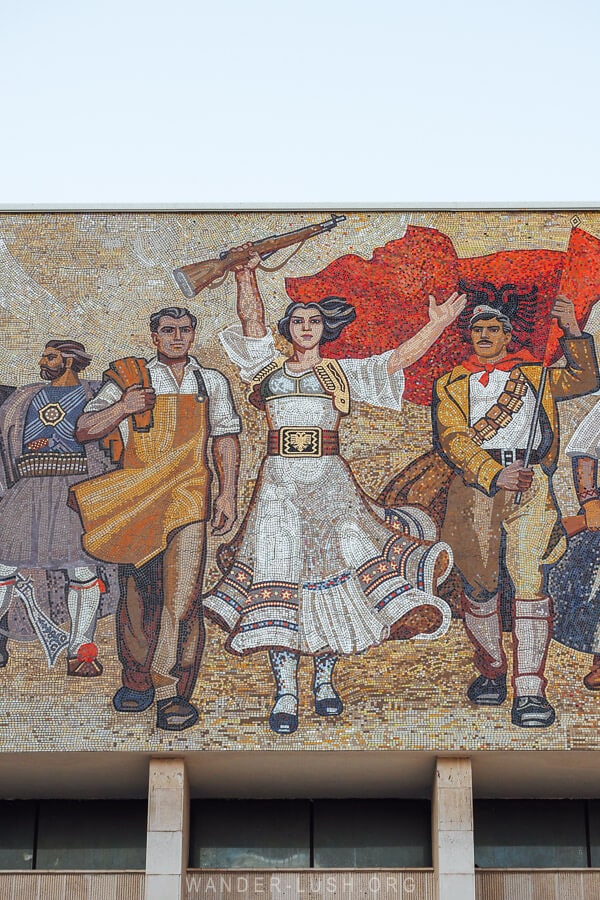
Do — Sightsee on Skanderbeg Square; visit Bunk’Art 2 Museum; climb the Pyramid of Tirana; dinner & drinks in Blloku.
Stay — Konak Skanderbeg Square offers self-contained apartments with a shared kitchen footsteps from the main square. The location is super convenient if you’re using the city bus to travel in from the airport and to the car rental office.
Further reading — My Tirana city guide.
Day 1: Tirana to Berat
- Distance covered today: 100 kilometres (62 miles)
- Time in the car today: Approx. 2.5 hours
- Recommended route: Backroad through Picall > SH A3 via Kucove
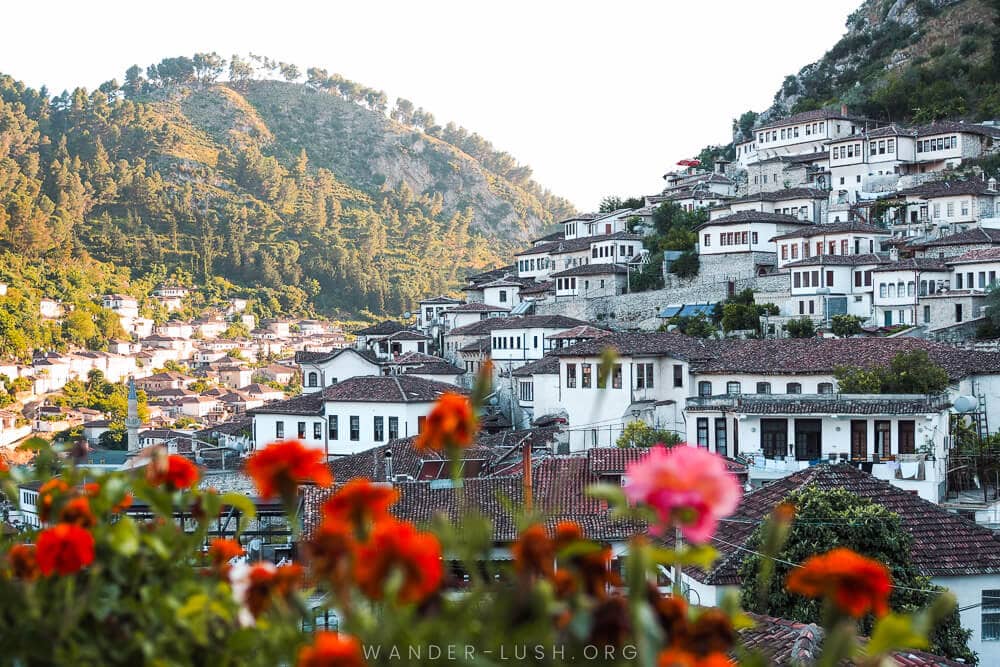
Having arrived in Tirana a few days prior, we elected to collect our rental car from the agent’s office in the city centre. This meant we didn’t have to backtrack to the airport – to get to the office, we simply jumped on a city bus. It also meant that we could get straight onto the highway without driving through the city centre – a huge plus, since traffic in Tirana is always chaotic.
As is typical of my experience with Local Rent, the hand-over was very low-key. We signed our contract, paid in cash, and gave our car – a Ford Fiesta – a quick look over before setting off.
Whenever we drive in a new country, I find it helpful to pinpoint a couple of road stops within the first 30-60 minutes. The idea is to slowly warm up and have somewhere very specific to aim for.
Leaving Tirana, we headed straight to the Lapidari 2 Viewpoint (15 mins) on the southwestern side of the city. Our aim was to get a city view without putting in the legwork – it didn’t quite pan out, though. When we arrived, we discovered the road to the viewpoint was blocked to cars. We didn’t feel like walking for 45 minutes in the heat, so we abandoned ship.
It was still a good decision in hindsight because it introduced us to a backroad that we could use to travel down to our lunch spot, Fustanella Farm. The country road was completely empty and very scenic.
Fustanella Farm (30 mins) is a gorgeous farm-to-table restaurant on the outskirts of Tirana, with a rustic outdoor dining terrace set amongst olive and fig groves. It is perfectly positioned for a lunchtime stopover on the drive to Berat.
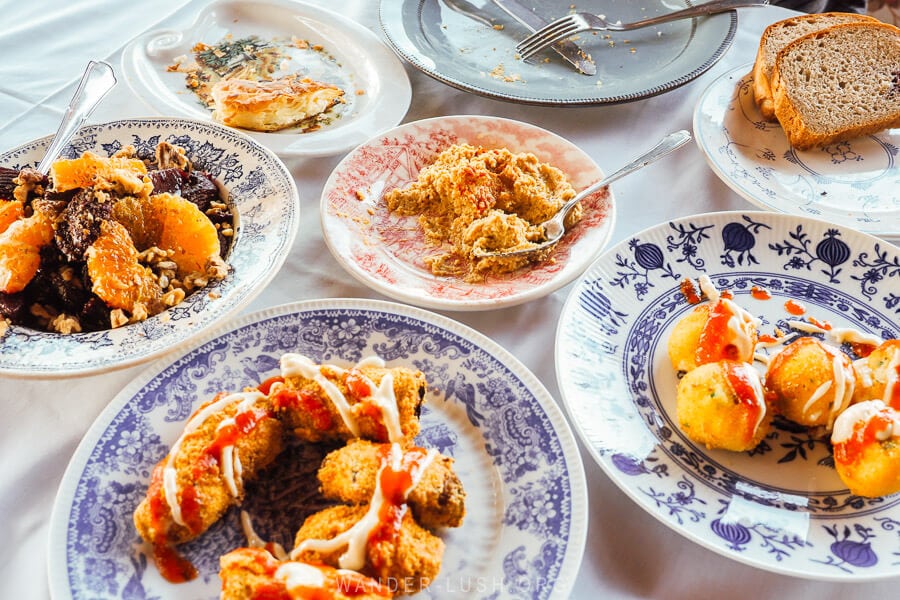
Halfway through an incredible lunch, we got a call from the rental office informing us we had left Ross’s driving licence in their photocopy machine. So unfortunately we had to turn around and head back to the city (luckily it was only a 20-minute detour on the highway). Driving back into Tirana at peak hour was a bit of a nightmare.
If it hadn’t been for that error, we could have connected directly to the highway and reached Berat in around 1.5 hours. Having wasted more than an hour backtracking to Tirana, we had to eliminate some stops from our itinerary. If you are making good time, there are several wineries located on the way into Berat, including Kantina Edoni and Kantina Luani. We only had time for a quick walk around the park in the industrial city of Kucove, which is arranged around old smokestacks.
It was late afternoon when we finally pulled into Berat. For a memorable experience, I highly recommend staying inside the castle grounds like we did. Be sure to take the turnoff after the bus station and use Rruga Muzak Topia to approach the castle from the back side (the main road is very steep and narrow). Some of the cobbled streets inside the castle peter out and turn into impassable laneways, so stick to the main streets and park wherever you see vehicles congregating. Our guesthouse provided clear instructions in advance.
After checking in, we went for an evening wander around the castle grounds before a well-deserved Birra Korca and an easy dinner at one of the restaurants inside the castle.
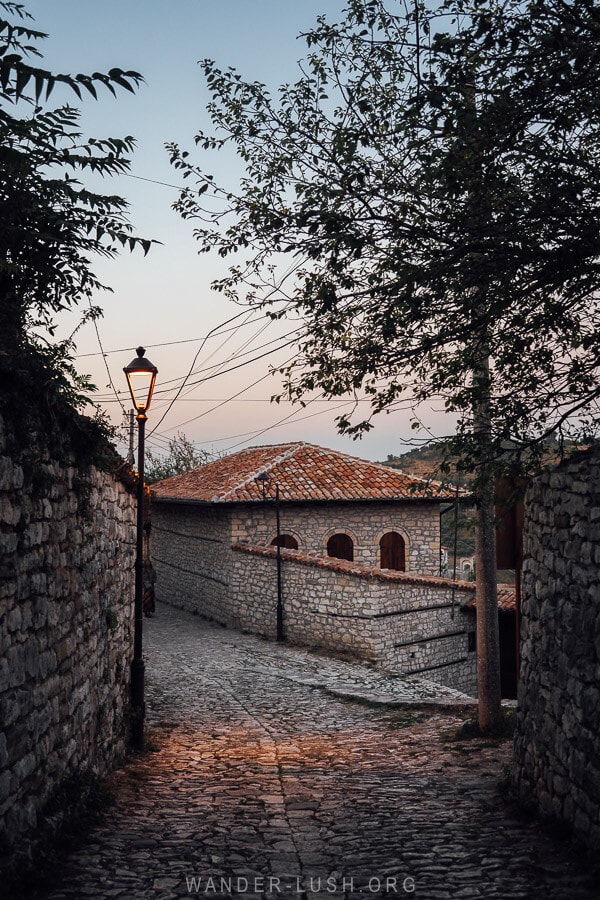
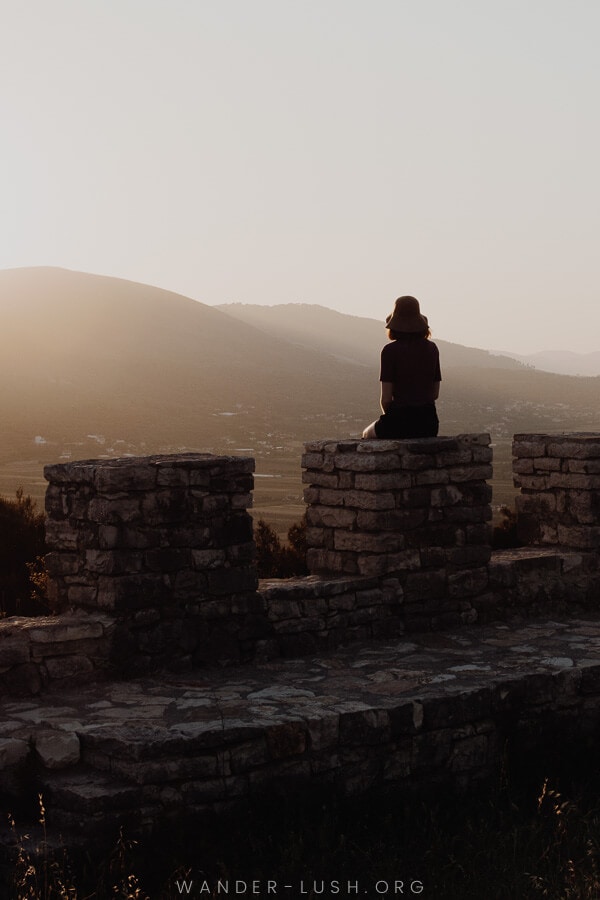
Stop — Lapidari 2 viewpoint; Fustanella Farm; Kucove; Kantina Edoni or Kantina Luani wineries.
Park — Free street parking is available inside Berat Castle.
Do — Evening walk through Berat Castle; sundowners at Te Zalua; dinner at TEMI.
Stay — Bed & Breakfast Josiph inside the Berat Castle walls (night 1/2).
Day 2: Full day in Berat
There is enough to see and do in Berat to comfortably fill a full day. A huge perk of staying inside the castle is being able to step out into the most beautiful part of Berat before the mid-morning crowds arrive.
We started our morning in the castle then made our way down the hill to cover Berat’s twin neighbourhoods, Gorica and Mangalem. During the hottest part of the day we found some respite by taking the audio tour at the Onufri Museum. Then we visited a few of the Byzantine churches, and enjoyed another stunning sunset from the castle grounds.
If a full day in Berat is too much, there is an option to take your car out for a drive in the afternoon. You can backtrack to a winery, or venture in the opposite direction to Osumi Canyon, 90 minutes away. There are waterfalls and caves nearby that you can also access by car. We visited Osumi on our first trip to Albania (in summer) and thoroughly enjoyed it.
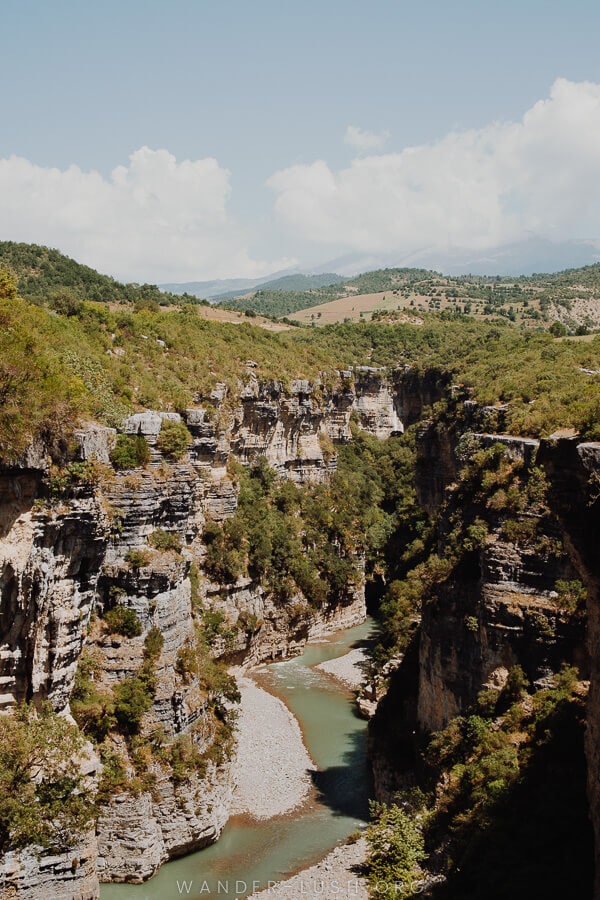
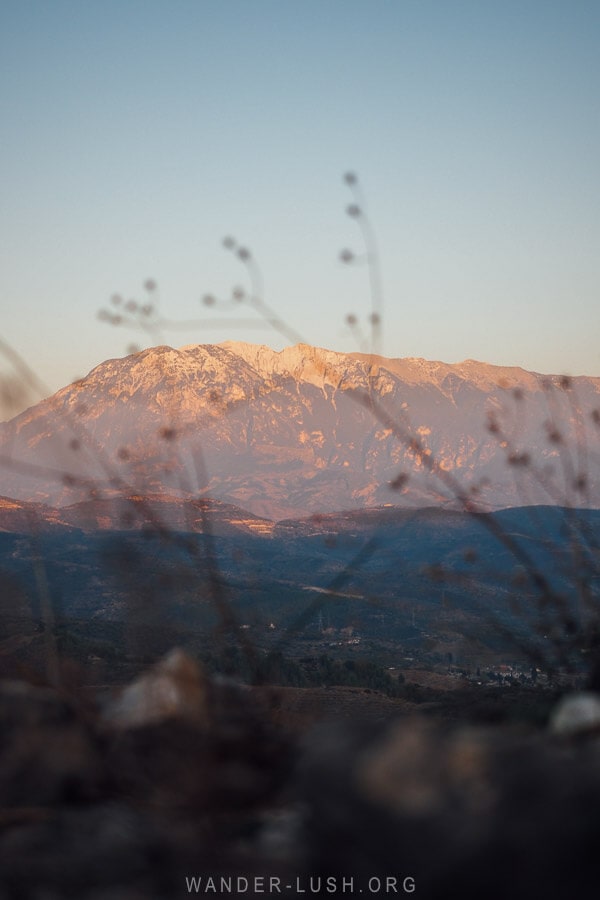
Do — Early morning walk in the castle; explore the Gorica and Mangalem Quarters; afternoon at a winery or Osumi Canyon (optional).
Stay — Bed & Breakfast Josiph (night 2/2).
Further reading — My full guide to Berat.
Day 3: Berat to the Albanian Riviera
- Distance covered today: 203 kilometres (126 miles)
- Time in the car today: Approx. 4.5 hours
- Recommended route: SH72 > SH4 > coastal road (SH8)
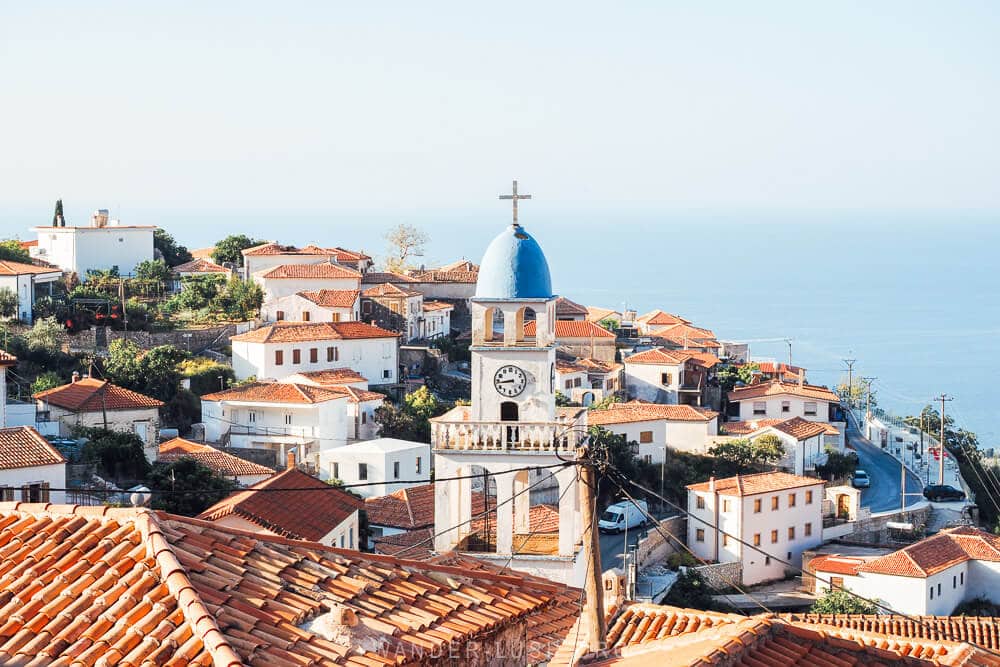
Despite having little interest in Albania’s beaches, we gave ourselves four full days on the Riviera with the goal of exploring the hillside villages behind the coast. If you are a beach person, three nights is ample time to get your dose of sand and sun.
Knowing we had a full day of sightseeing ahead of us, we organised to stay at the northern end of the Riviera to shave just that little bit of driving time off. The tiny village of Dhermi turned out to be one of my favourite places in Albania, with enough beach and non-beach activities to keep you occupied in any season.
Apollonia (75 mins) is a tentative UNESCO Site and the first of several Greek/Roman/Illyrian archaeological parks featured on this itinerary. In many ways I preferred it over the more-popular Butrint – you can be the judge (Butrint is coming up on day 6).
Founded in the 6th century BC, Apollonia was one of the largest settlements on the Adriatic. The thing that sets it apart (aside from its scale) is the fact that it had its own sculpture school. Thus the small museum inside the Archaeological Park is filled with incredible statues.
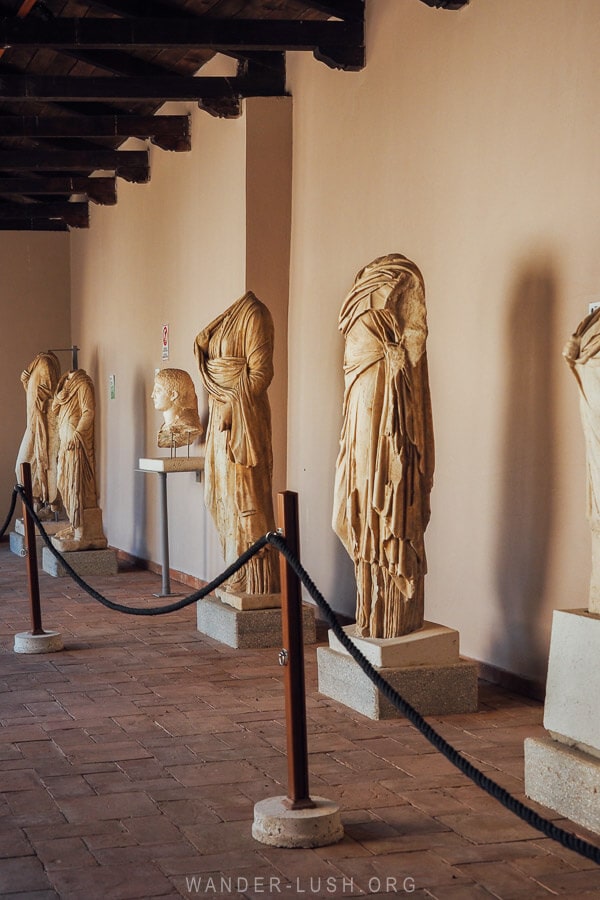
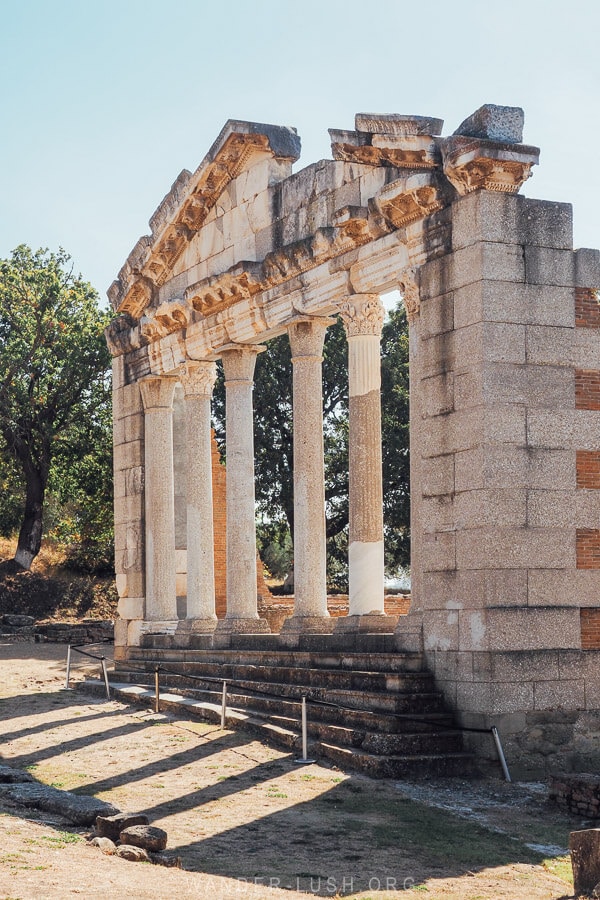
We set off early from Berat with the aim of arriving at Apollonia at opening time (9am during winter). The entire complex is outdoors and very spread out – it requires a fair bit of walking, so it’s best to avoid visiting during the hottest part of the day.
When preparing for this trip, I had read about an abandoned steam-power plant near the park. So we made a quick stop in the city of Fier for a hit of urbexing. A man in a reflective vest showed us around a few of the concrete carcasses and took us inside one of the abandoned cooling towers – unfortunately things went sour when he started demanding money from us for the ‘tour’. A little shaken up after his empty threats to call the police on us, we had to hotfoot it out of there.
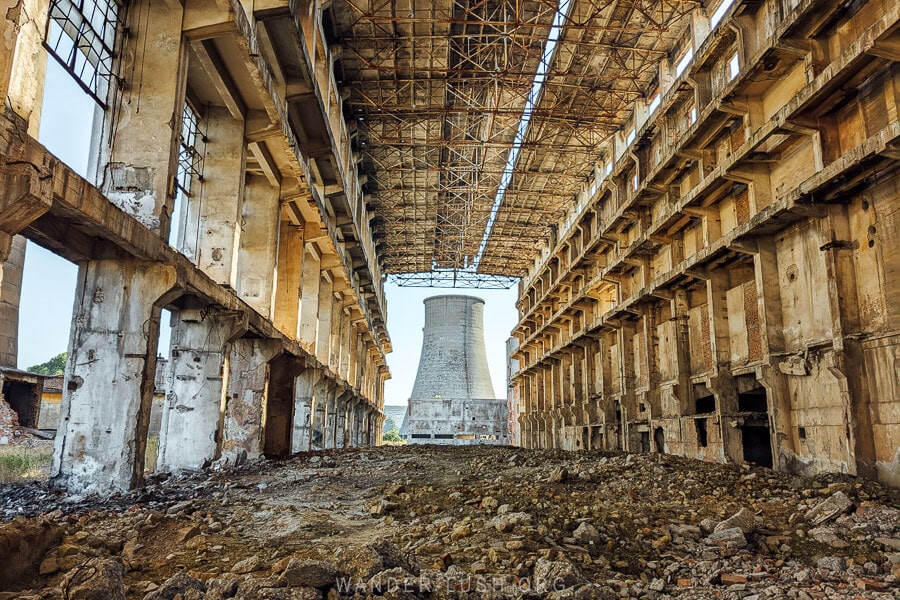
Our next stop was a lot more vanilla. Albania’s third-largest city, Vlora (30 mins), boasts two of my favourite things: a pretty old town filled with colourful facades, and an impressive WWII memorial. We parked our car on a quiet side street and visited both on foot.
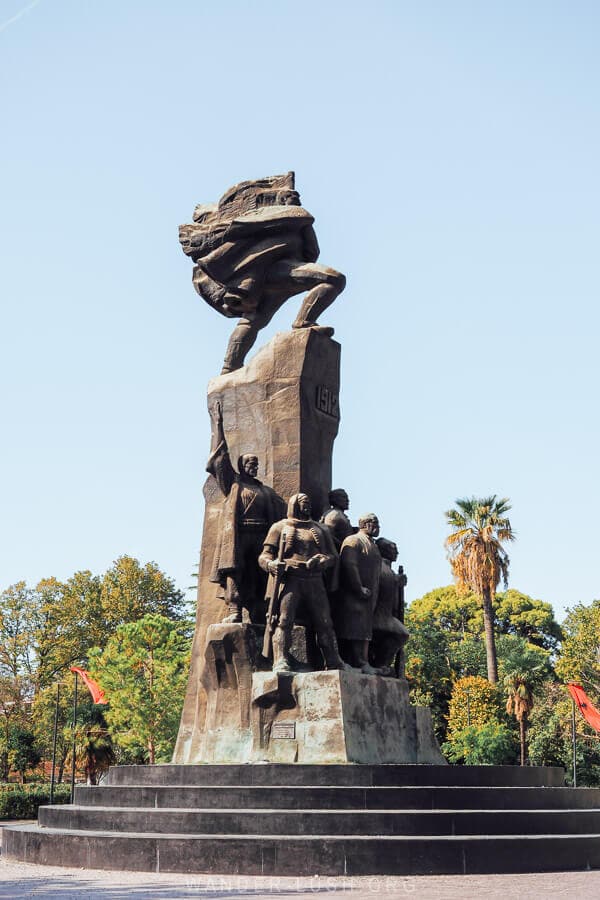
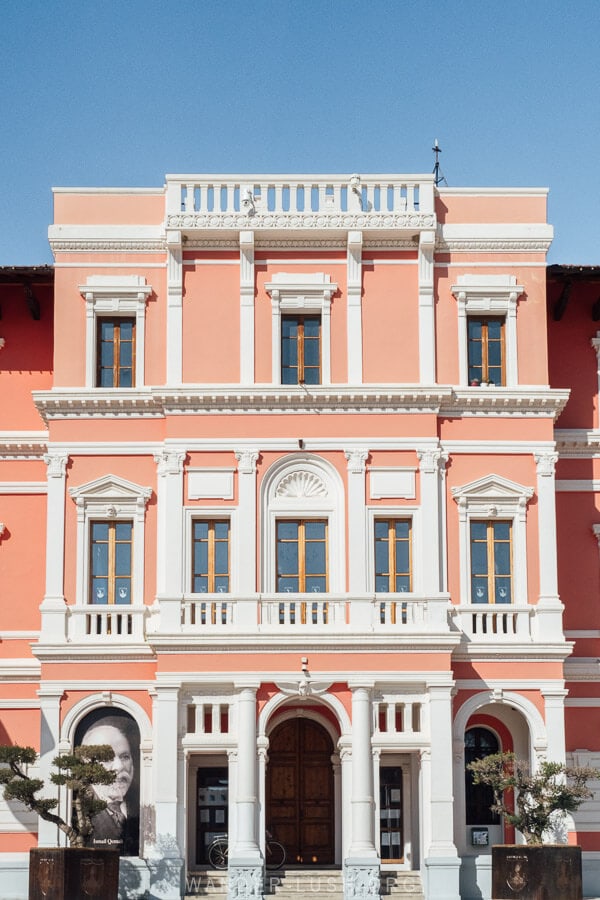
One of the main reasons I wanted to return to Albania was to spend more time around the Vjosa, one of Europe’s last wild rivers. It spills out into the Adriatic near Vlora, so I couldn’t miss the chance to see the Vjosa-Narta Delta Protected Area.
The Zvernec Islands sit in the delta’s Narta Lagoon and are the best access point if you don’t have a 4WD (if you do, off-road tracks are available on the northern side of the lagoon for birdwatching and secluded beaches). We drove the scenic road through a pine forest (approx. 30 minutes from Vlora) to the Zvernec Bridge and crossed the boardwalk over the marshes to the 13th-century St. Mary’s Monastery.
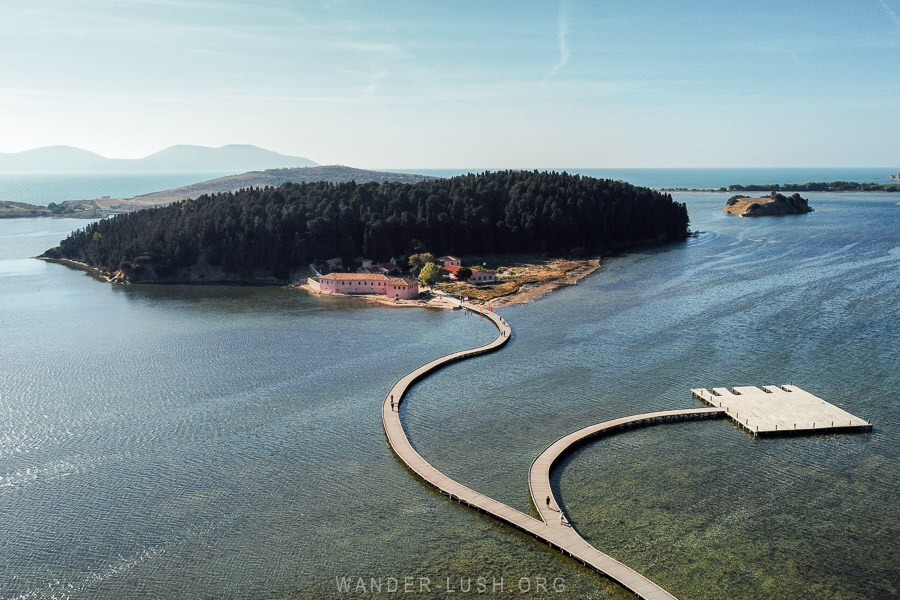
Departing Vlora, we headed south along the coast towards the Riviera proper and arrived at the Llogara Pass (45 mins) just as the light was dwindling. This 15-kilometre stretch of highway is one of the most scenic roads I have ever been on – up there with the Kotor Serpentine that we drove in Montenegro. As you crawl down the mountain, you descend into a sea of low clouds, with the Adriatic stretched out before you like a blue satin sheet.
The marked viewing platform on the highway was quite crowded, so we continued down the road a little further to the ’Big Bunker’, a Hoxha-era monstrosity perched on the cliff. We climbed down into the bunker and got a front-row seat for sunset.
Dhermi is one of the first major villages you come to after descending the pass, so you can catch the sunset and still make it to your accommodation before dark. We did just that, arriving in time to enjoy a twilight beer on our little terrace at Roots Dhermi.
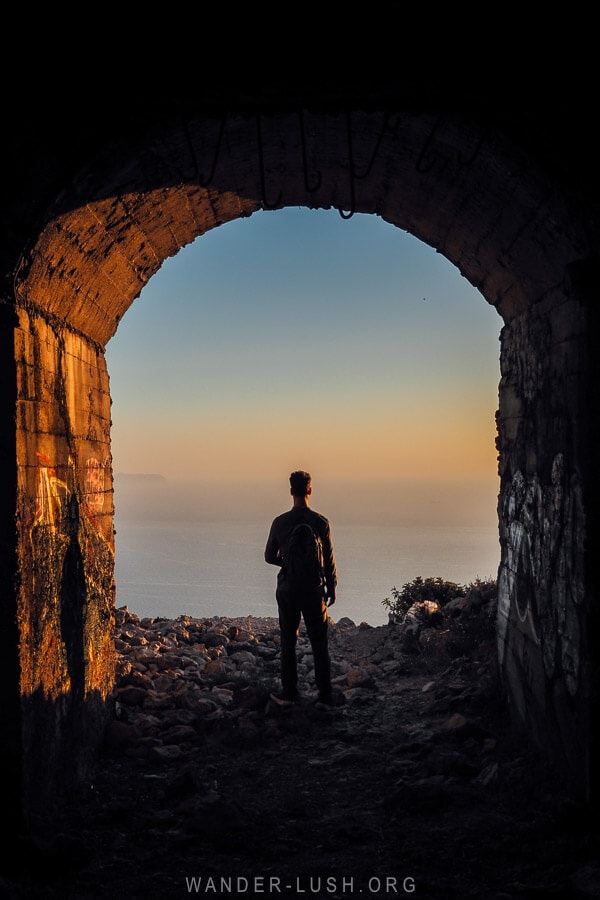
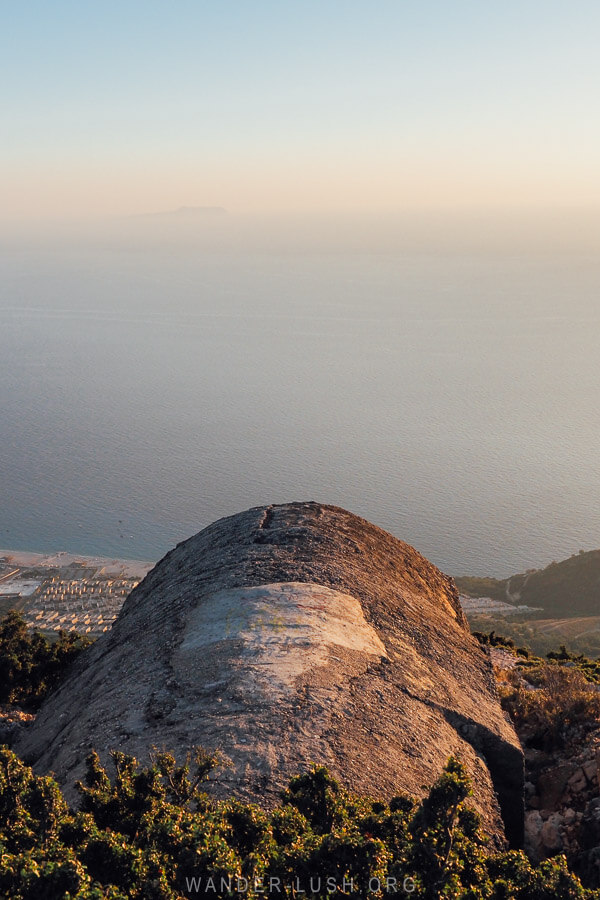
Stop — Apollonia Archaeological Park; Fier; Vlora & the Zvernec Islands; the Big Bunker & other viewpoints on the Llogara Pass.
Park — Free street parking is easy to come by in Dhermi out of season. If you see a congregation of cars near an intersection, chances are the surrounding streets are either too narrow or too steep to navigate. Follow suit and find a park where there are other cars gathered.
Do — Tour the Apollonia Archaeological Park; urbex at the Fier Kraftwerks; grab lunch in Vlora old town; walk the boardwalk to St Mary’s Monastery; drive the Llogara Pass; watch the sunset at the Big Bunker.
Stay — Roots Dhermi (night 1/2).
Day 4: Full day in Dhermi
Dhermi is split into two parts: the lower and newer Dhermi is a beach resort like any other, with bars and hotel developments cramped along a pebble shore. The older part of Dhermi, the upper village, is a world apart. All white-washed houses and cobbled lanes with a blue-domed Greek-style church belltower stealing the show, the restored village is one of the most beautiful places in Albania.
We gave ourselves a full day in Dhermi to wander the streets at sunrise and sunset, walk the historic Mills Trail down to the waterfront, and stroll along the restored promenade.
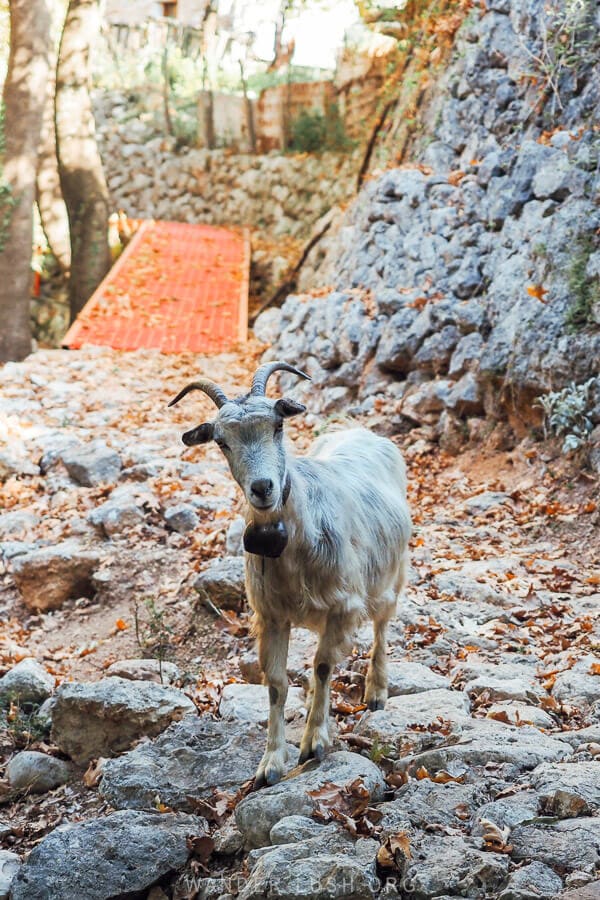
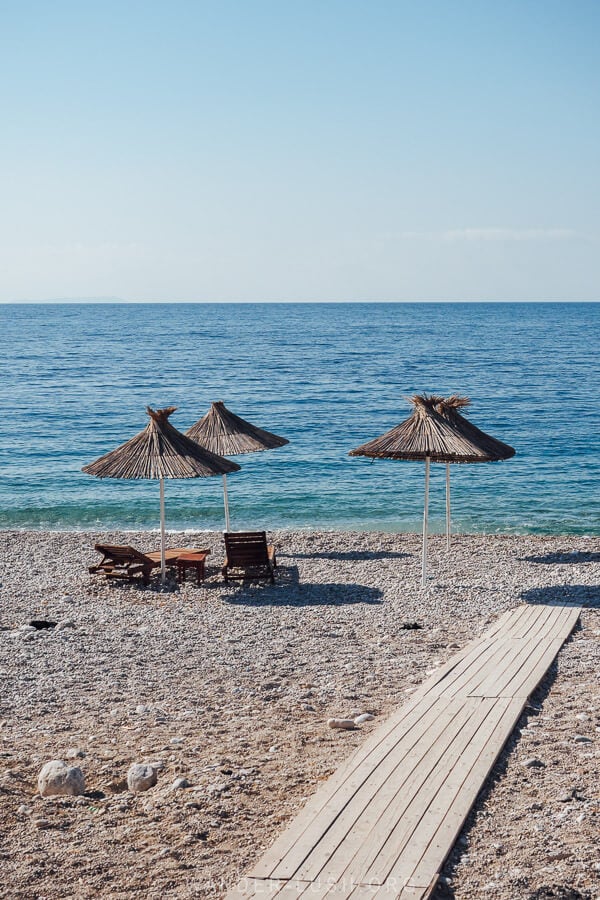
Dhermiu Beach is clean and relatively quiet, making it a good choice for swimming. Alternatively, the trailhead through Gjipe Canyon to the popular Gjipe Beach is just a 7-minute drive away in Iljas – we considered it, but decided to spend our afternoon eating tzatziki in Dhermi instead.
Food options in Dhermi are limited in the off-season. We ate our breakfasts (Italian coffee and byrek) at Barba Niko Bakery and had a nice pasta lunch directly opposite at Restorant Genti. For dinner, Sofia Bar in Dhermi serves grilled fish and a mean tzatziki. The terrace here is a prime spot for sunset.
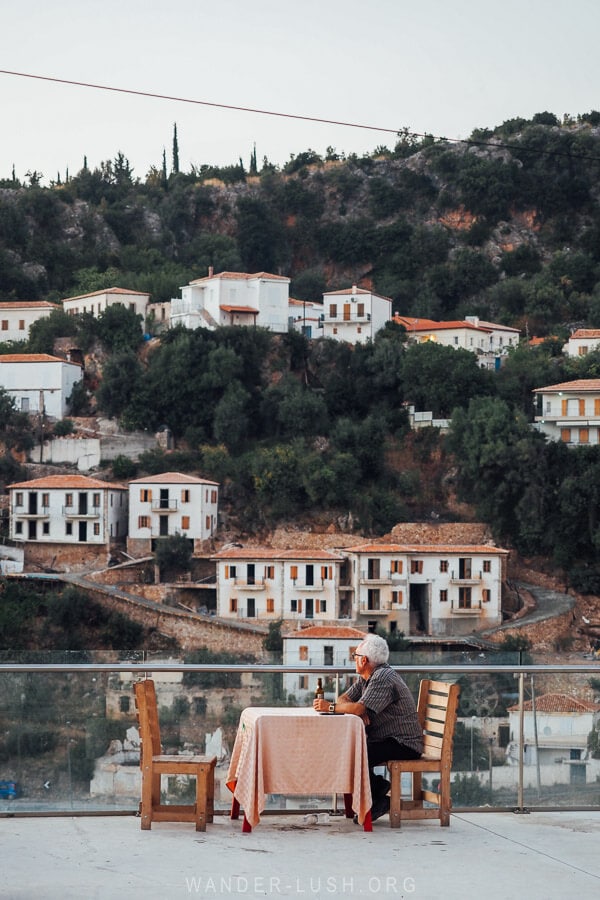
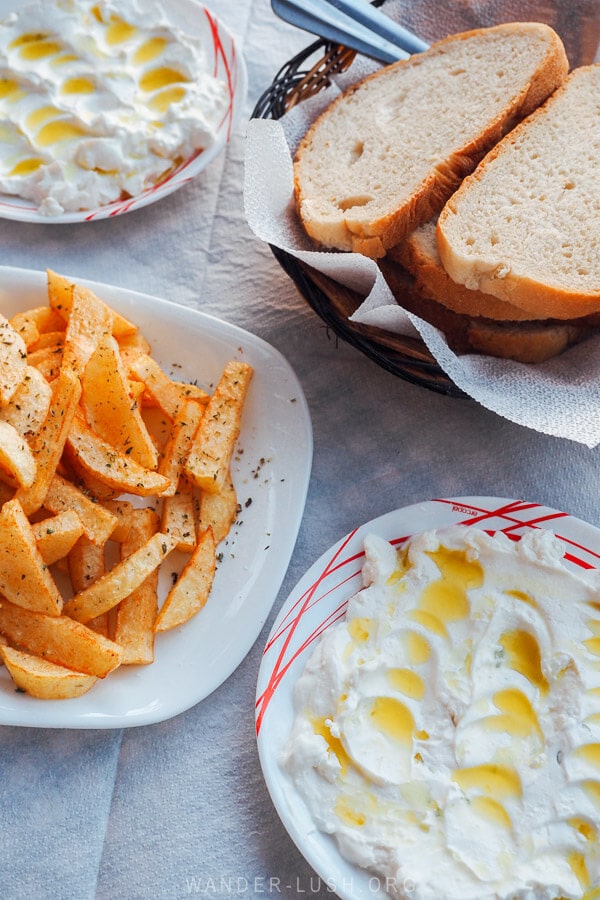
Park — We left our car in the same spot for most of the day. To save time, we drove to the local bakery to pick up breakfast and drove into town for lunch. Street parking was easy to find on both occasions.
Do — Explore charming Dhermi; hike the Mills Trail to Dhermi Beach; lunch in Dhermi town; Gjipe Canyon & Beach (optional).
Stay — Roots Dhermi (night 2/2).
Further reading — Things to do in and around Dhermi.
Day 5: Dhermi to Upper Qeparo
- Distance covered today: 35 kilometres (22 miles)
- Time in the car today: Approx. 60 minutes
- Recommended route: SH8
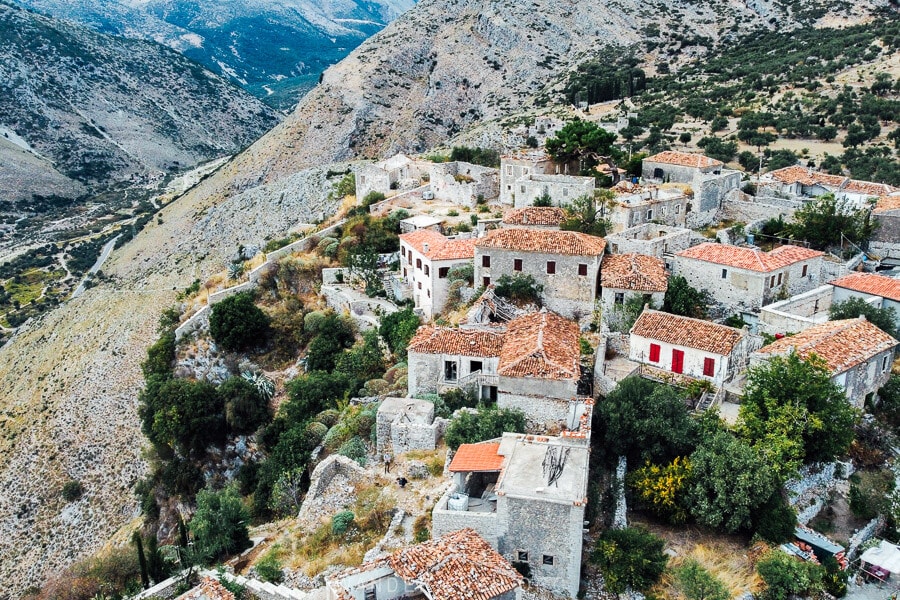
Qeparo is another lovely beach town 40 minutes south of Dhermi. Its proximity to both excellent beaches and several more villages and castles makes it a convenient base.
Like Dhermi, Qeparo is split into an upper and lower village – but the difference is much more stark. Upper Qeparo has not been restored and is partially abandoned, with a good portion of its stone houses in a state of disrepair. A rare example of traditional Albanian village architecture as it was, its beauty is more the decrepit kind.
We spent two nights in Upper Qeparo, but on one of those days it was raining (good timing for us because we were due for a lazy day). An afternoon plus a morning in Qeparo is ample time to explore the village.
Day 5 of our road trip was packed with stop-overs as we hopped down to Qeparo over the course of around five hours. We arrived in Vuno (15 mins) bright and early and were the only two pairs of feet padding the stone streets under vaulted arches. The incredible St. Nicholas Church – a forgotten chapel with vivid frescoes totally exposed to the elements – was a highlight.
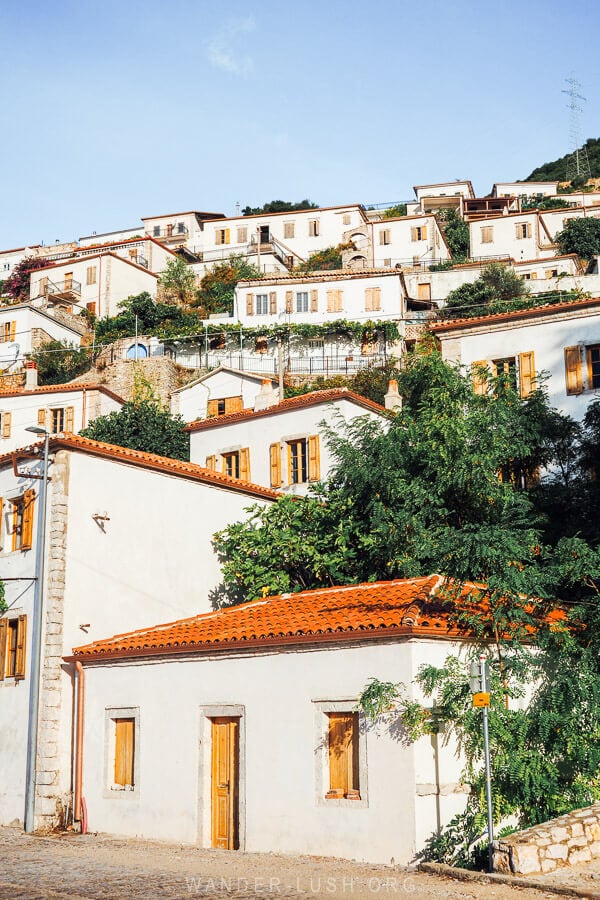
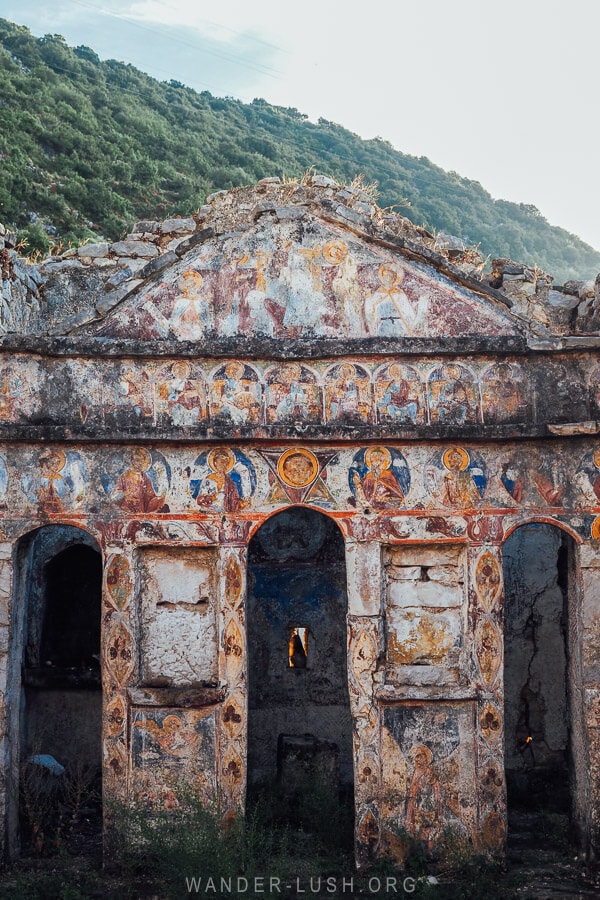
Himara Castle (15 mins) commands exceptional sea views and was another highlight of the Riviera for me. Cafe Butterfly inside the fortress grounds serves good coffee and sweet snacks.
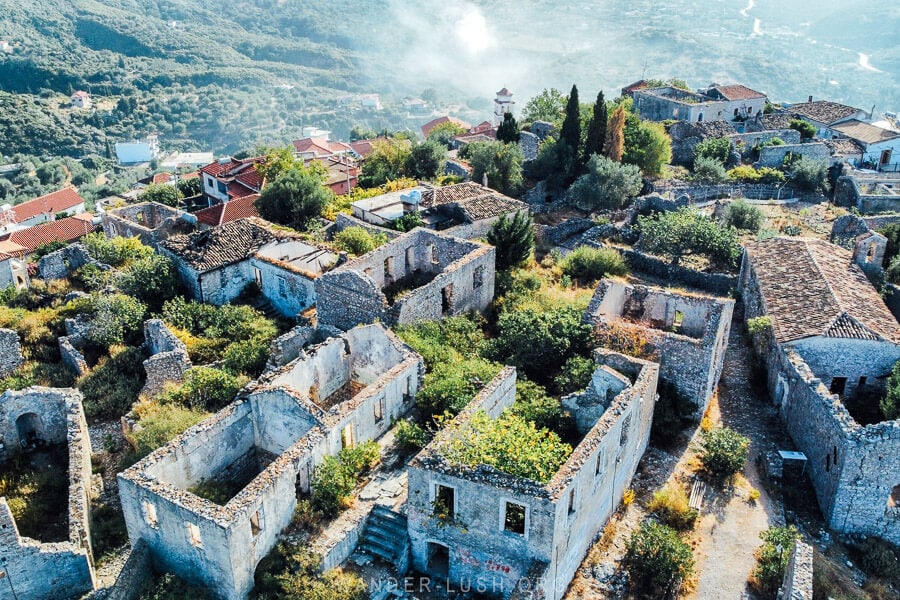
We had planned to drive down to the ‘Submarine Bunker’ in Porto Palermo, but after seeing it from afar from the highway, we decided against it. As much as I would have liked to swim into the concrete tunnel, it wasn’t quite what I imagined – and the road down looked dicey.
Unfortunately we arrived to find Porto Palermo Castle (25 mins) closed on a Monday (the schedule changes in mid-October), so we flew our drone over the triangular fortification instead.
The road to Upper Qeparo (25 mins) is steep but short and fully sealed. We arrived in the village with a couple of daylight hours to spare, and spent them getting lost on the backstreets and walking through the olive groves to Ali Pasha’s Tower before settling down to a delicious dinner at Te Rrapi ne Qeparo.
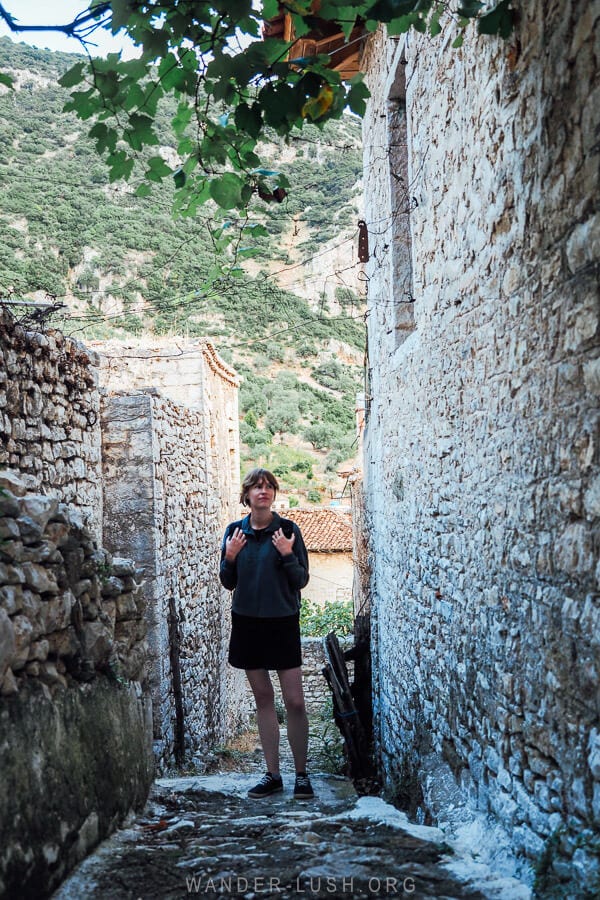
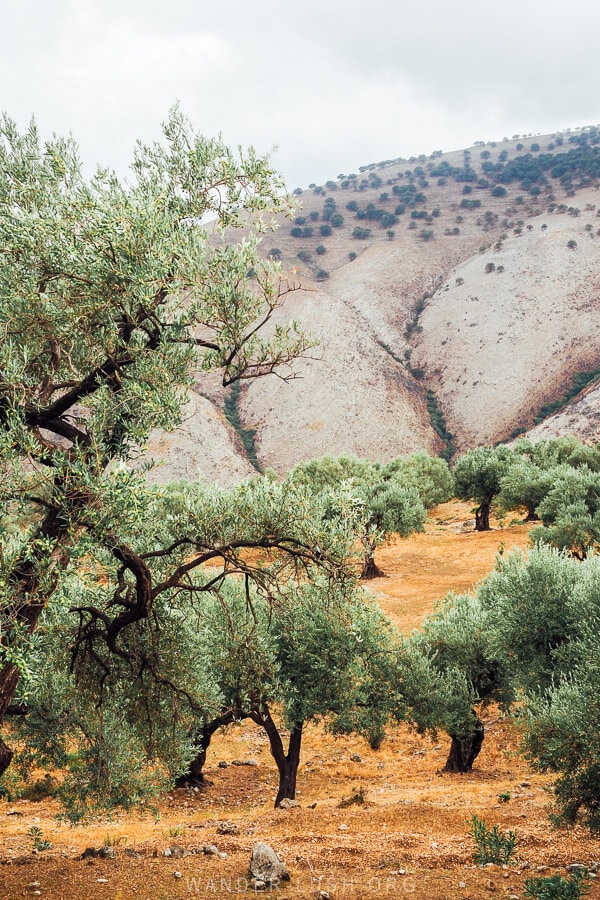
Stop — Vuno; Gjipe Canyon & Beach (optional); Himare Castle; the Submarine Bunker viewpoint; Porto Palermo Castle.
Park — We parked our car at this wide crossroads at the entrance to the village. It is possible to drive deeper into the village, but we didn’t want to risk it.
Do — Wander the cobbled streets of Vuno & find St. Nicholas Church; explore Himare Castle; stop for a view of the Submarine Bunker; visit Porto Palermo Castle; afternoon stroll through Upper Qeparo; dinner at Te Rrapi ne Qeparo.
Stay — Villa Porta Qeparo.
Further reading — My guide to Old Qeparo.
Day 6: Upper Qeparo to Gjirokaster
- Distance covered today: 133 kilometres (83 miles)
- Time in the car today: Approx. 3.5 hours
- Recommended route: SH8 > SH81 > SH99 > SH4
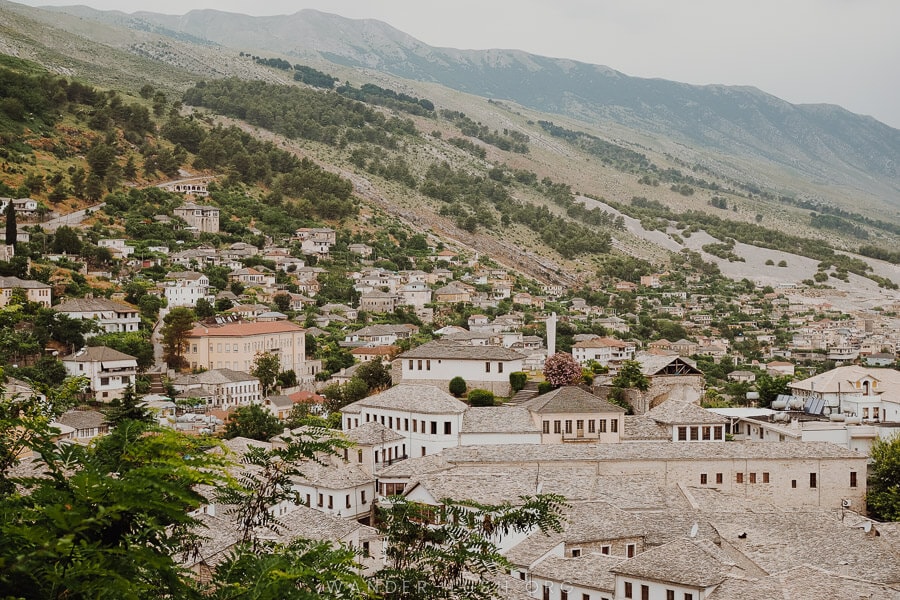
The drive inland from Qeparo to Gjirokaster was by far the longest of our trip. I was a little concerned that we would run out of time, but we managed to fit everything in.
Bookended with an indulgent breakfast in Saranda and golden hour at the Field of Bunkers, it was a perfect day from start to finish. My only regret is not spending longer in Saranda – I really liked the city’s aesthetic – but after four days, we were more than ready to leave the beach behind.
Leaving Qeparo, we made a beeline for Saranda (60 mins) and had time for a short stroll on the waterfront before an excellent breakfast at Marini. Driving through the city during morning peak hour was a little sketchy – and it was challenging to find a park on the waterfront – so I recommend arriving as early as possible.
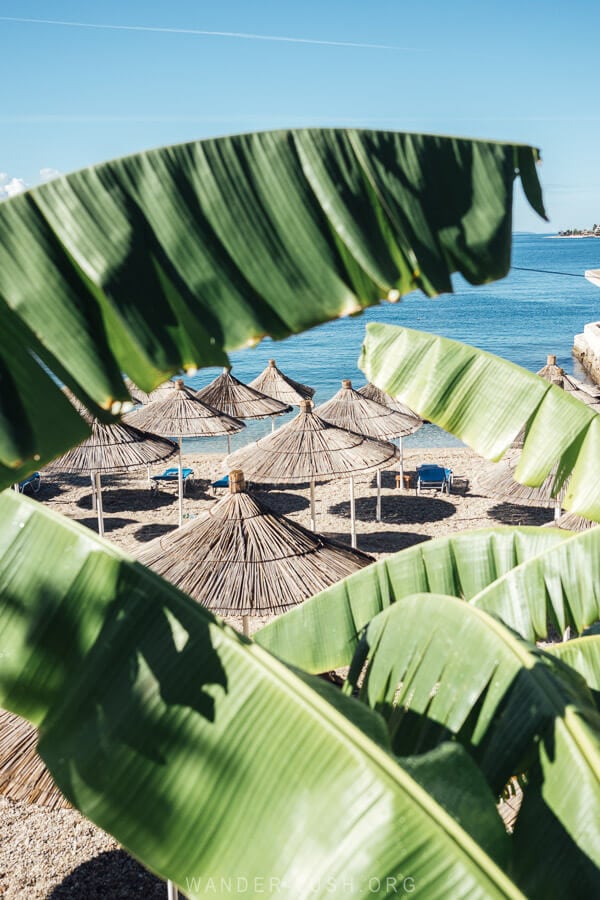
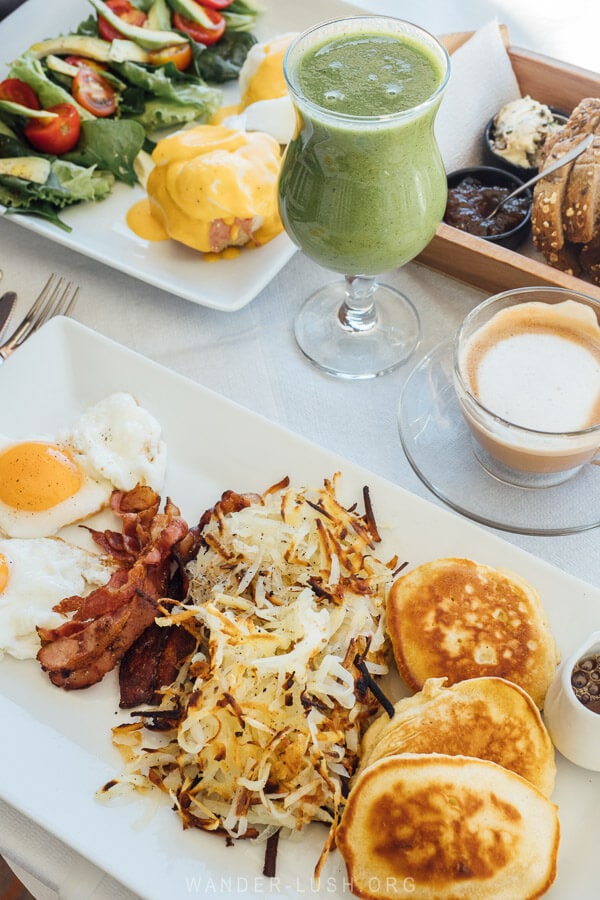
On the edge of Saranda, Butrint National Park is Albania’s most-visited attraction and oldest UNESCO Site. I had high expectations and to be completely honest, I found Butrint a bit disappointing. The Roman Forum was much smaller than I had imagined, and the floor that was previously flooded has been covered over. The museum was excellent, but having a guard shadow us the entire time to enforce a no-photo policy really detracted from the experience.
Most disappointingly of all, the baptistry mosaics pictured on every tourist brochure were completely covered in sand (later in the trip we would encounter the same thing in Lin). I had no idea this was standard practice – surely it’s possible to build a roof or insert a horizontal screen and project an image of the mosaics onto it?
The highlight of Butrint for me was the scenery and walking trails along the water.
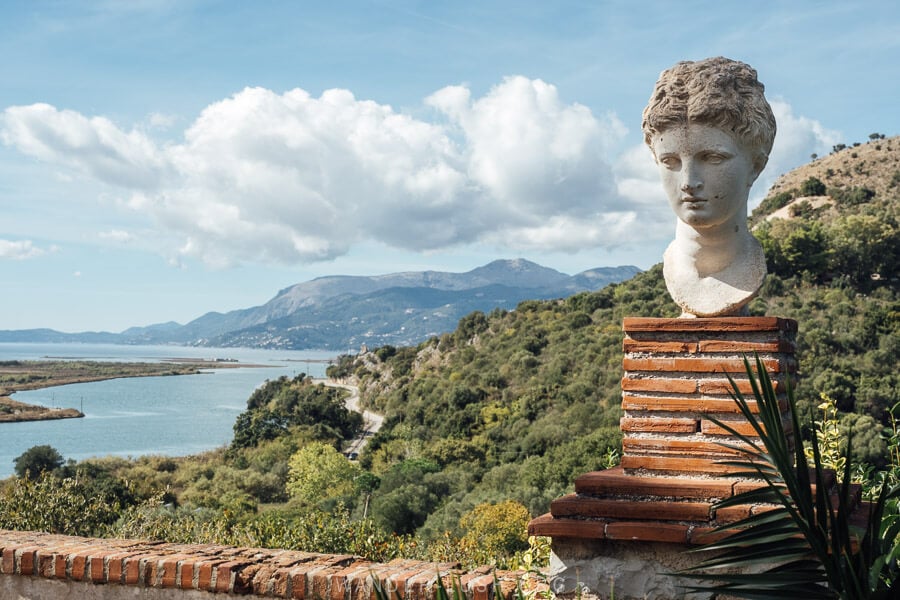
If we had more time, we could have explored Ksamil and its beaches and islands, or used the car ferry outside the archaeological park to access the Venetian Triangle Castle. Instead, we drove back through Saranda and headed east to start our journey towards Lake Ohrid on the opposite side of the country.
You need a solid two hours minimum to visit the Blue Eye or Syri i Kaltër (40 mins), a 164-feet-deep sinkhole enveloped in azure pools and lush forest. Though it is undeniably beautiful, I found it over-commercialised – the concrete road you have to walk to get there is an eyesore. I’m glad we went, but I don’t consider it an essential stop.
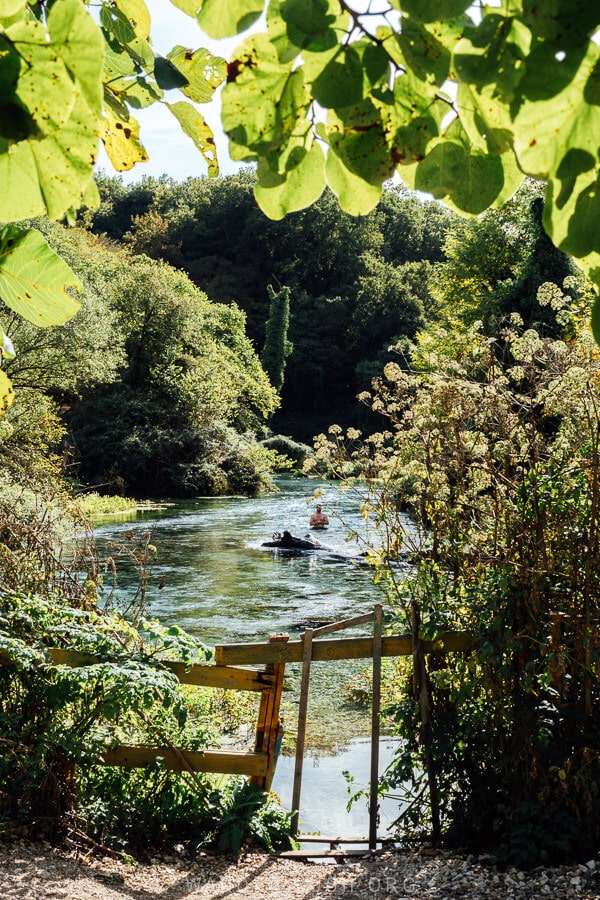
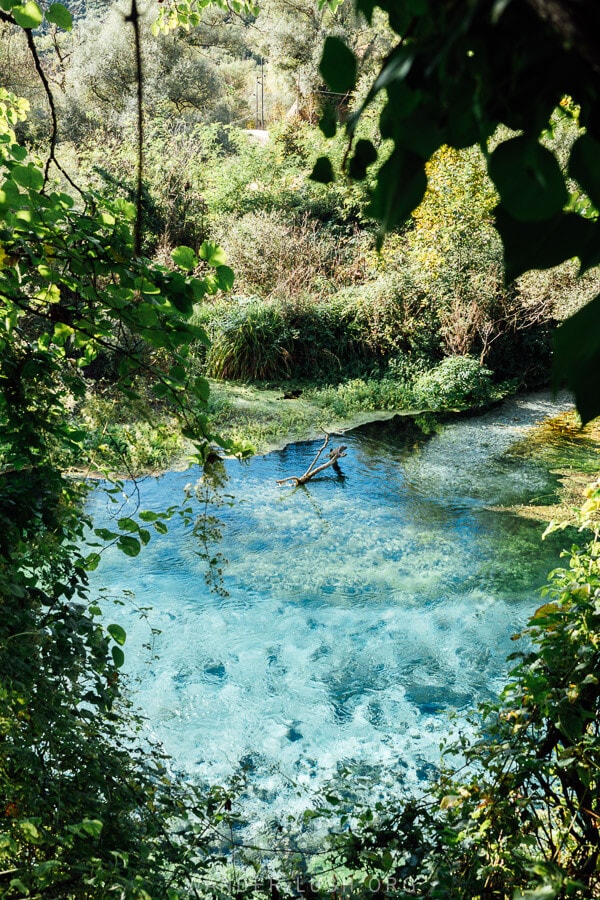
After driving another 30 minutes towards Gjirokaster, we got up close and personal with some of Albania’s concrete mushrooms at the Field of Bunkers (30 mins). There are a dozen or more bunkers of all shapes and sizes dotted around the field alongside a quarry – many have their original door mechanisms intact, and some are big enough to walk inside. Don’t follow Google Maps – take this turn-off instead.
There is an option to stop at the nearby Hadrianoplis Theatre, but the non-road requires a 4WD (or at least something more robust than a Fiesta).
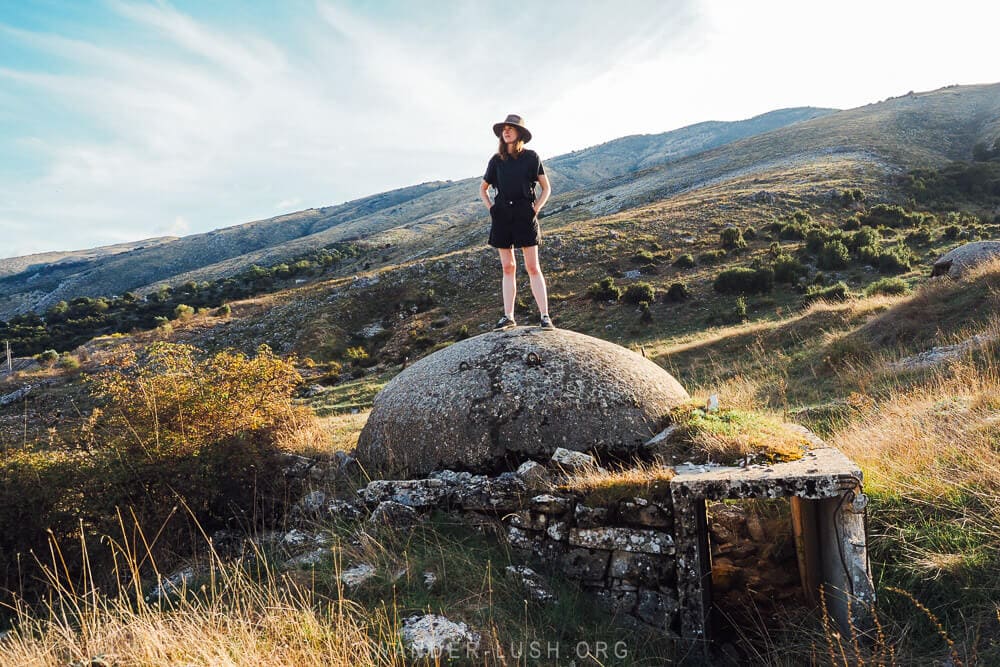
We arrived in Gjirokaster (30 mins) ahead of schedule and enjoyed a local dinner near our accommodation in the new part of the city. Gjirokaster was a breeze to navigate, and we had no issue finding a spot to leave the car.
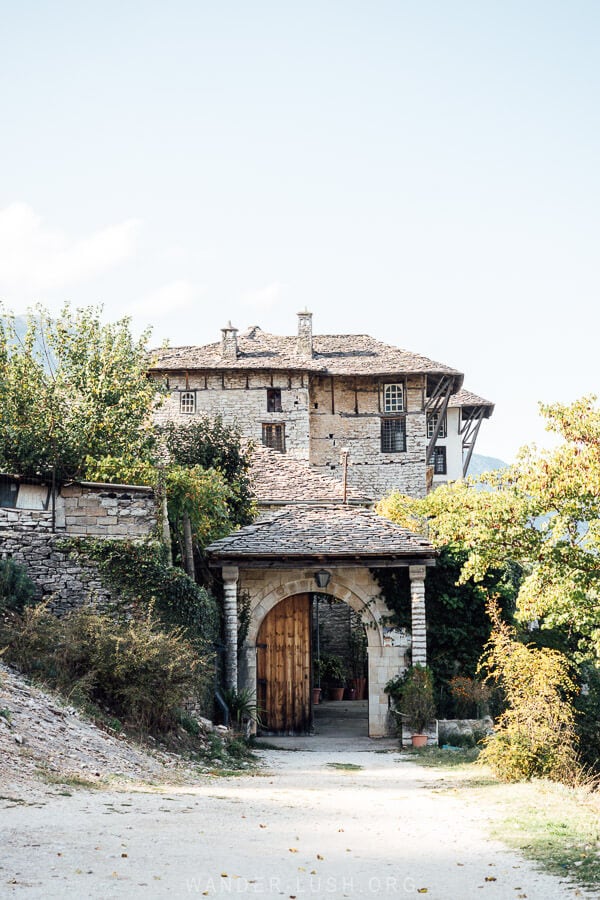
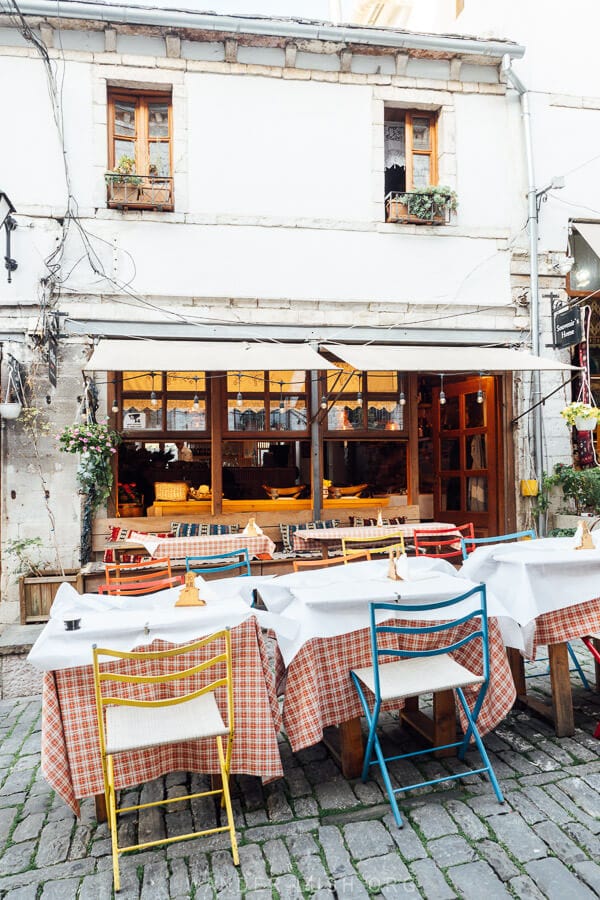
Stop — Saranda; Butrint National Park; Ksamil (optional); the Blue Eye; Field of Bunkers.
Park — Free street parking is available in Gjirokaster. We parked in the small lot attached to our apartment complex.
Do — Eat breakfast at Marini in Saranda; tour Butrint Archaeological Park; visit the Blue Eye; photograph the Field of Bunkers; dinner in Gjirokaster.
Stay — Jani Studio Apartments (night 1/2).
Day 7: Full day in Gjirokaster
Gjirokaster might be my favourite city in Albania. Like Berat, it has a historic ‘core’ that is protected under a shared 2005 UNESCO listing. Personally I prefer it over Berat – I adore the Old Bazaar area, and Gjirokaster has a greater variety of things to see and do.
We spent our day in Gjirokaster revisiting old favourites and ticking off a few things we missed the first time around. I highly recommend getting an early start and wandering the Old Bazaar just after dawn. The Obelisk is a must-visit for panoramic views.
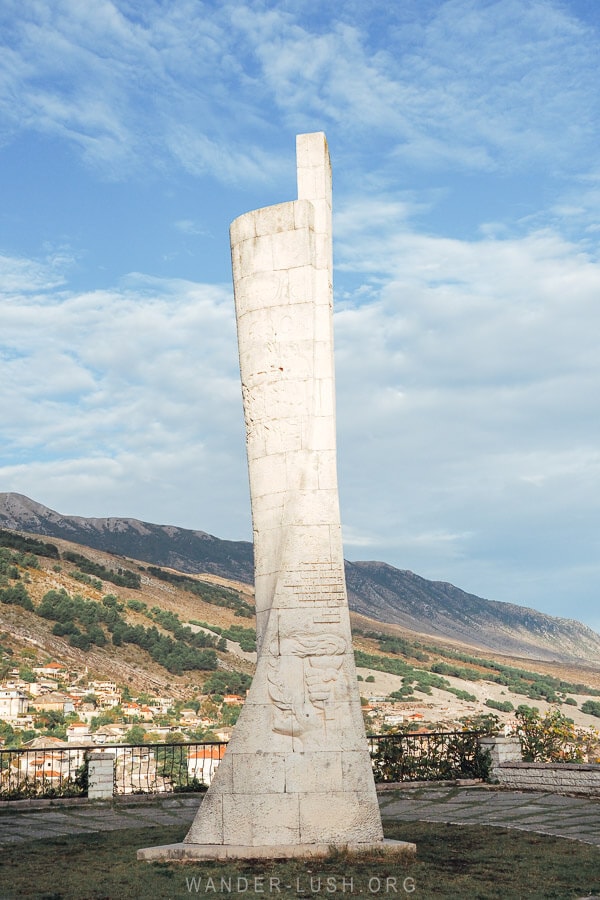
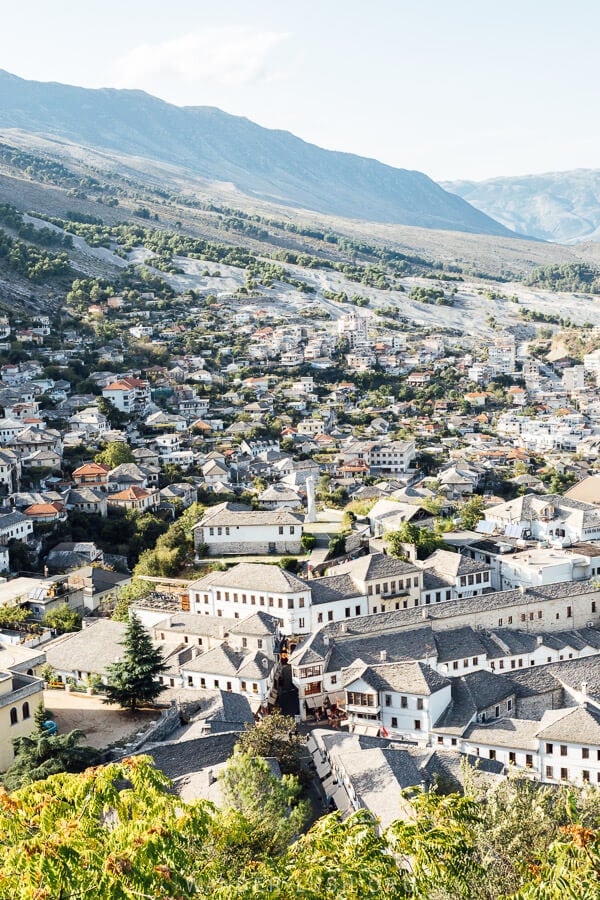
My highlights of Gjirokaster were touring the Cold War Tunnel, eating traditional oshaf fig pudding for breakfast, and going inside the magnificent Zekate House before walking the backroads to Gjirokaster Castle.
We waited out the warmest part of the day inside the Ethnographic Museum. Alternatively, you can stretch your legs on the 2-ish kilometre hike through town to Ali Pasha’s Bridge. We did it on our first visit to Gjirokaster – it has since become quite popular. (Tomorrow there is a more spectacular Ottoman-era aqueduct to see outside of Tepelena.)
We finished the day with a feast at Restorant Pajtimi, a humble local joint outside the tourist hub. Their version of tave kosi (Albania’s national dish of lamb baked in yogurt) was the best I had.
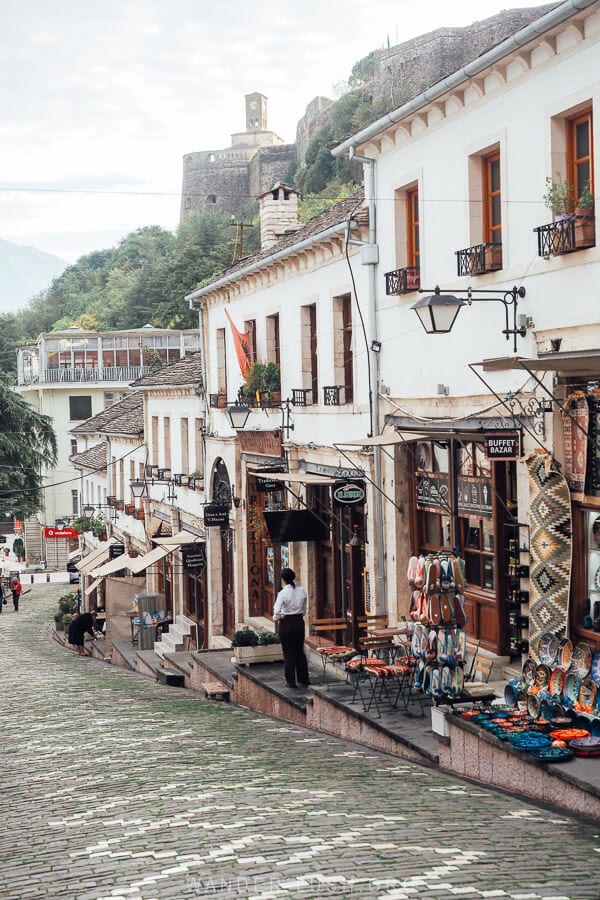
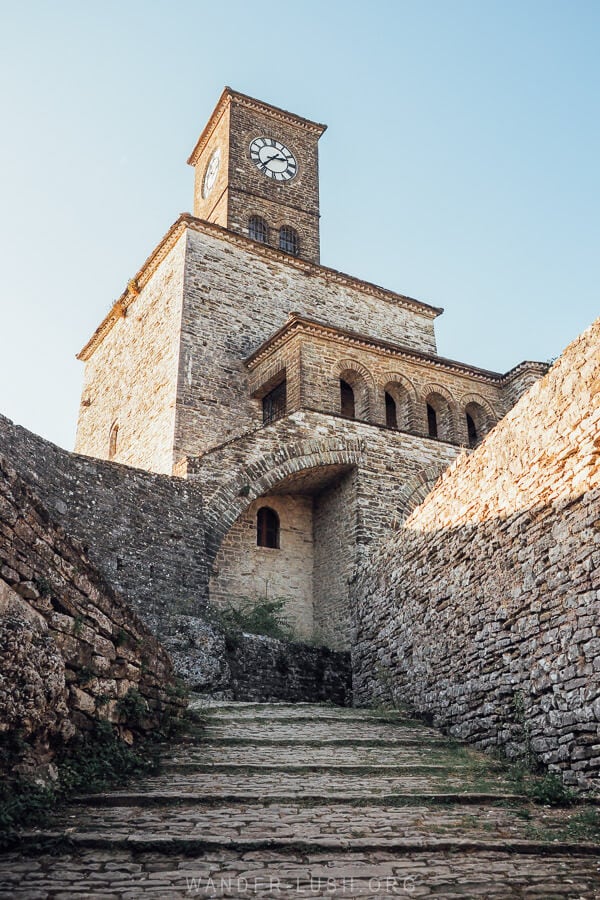
Do — Take an early morning stroll in the Gjirokaster Bazaar; tour the Cold War Tunnel; walk to Ali Pasha’s Bridge; visit Gjirokaster Castle for sunset; dinner at Restorant Pajtimi.
Stay — Jani Studio Apartments (night 2/2).
Further reading — 10 things to do in Gjirokaster.
Day 8: Gjirokaster to Permet
- Distance covered today: 84 kilometres (52 miles)
- Time in the car today: Approx. 2 hours
- Recommended route: SH4 > backroad towards Bence > SH75
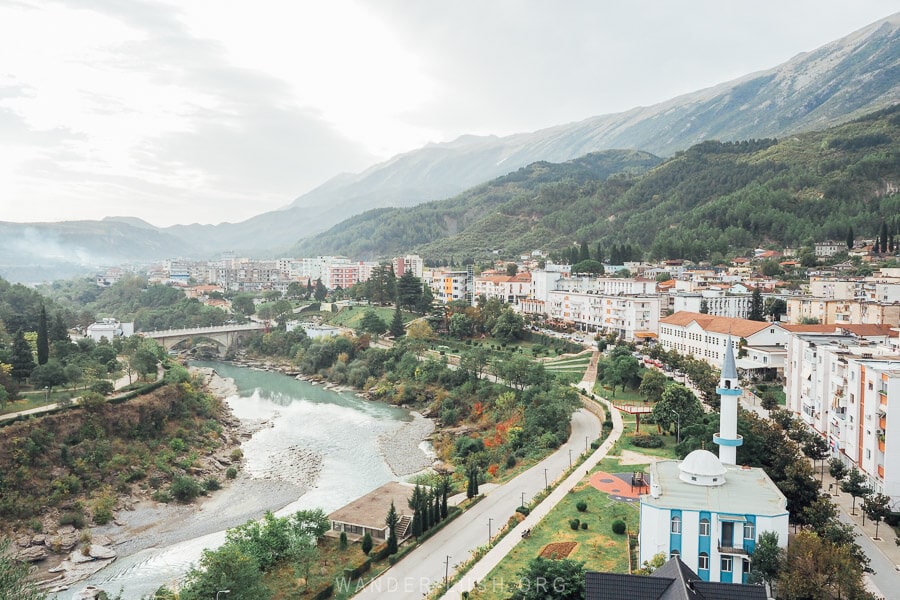
Pressing east from Gjirokaster we entered the most exciting phrase of our Albania itinerary. From this point on, it was all new territory for us (with the exception of Korca, which we had visited twice before) – and we were finally getting a glimpse of the Vjosa River, which was a major inspiration for the trip.
Permet on the Vjosa is a small city with huge potential. It is the self-appointed nucleus of Albania’s emerging Slow Food movement, with half a dozen or more restaurants that respect the philosophy. It is also a burgeoning ecotourism destination, with hiking and mountain biking trails popping up along the river and in the nearby Fir of Hotova National Park.
We were happy with our decision to stay in Permet for two nights – I loved the town’s aesthetic, and it meant we could try more restaurants (we managed five in total!). On our first night, we treated ourselves to a suite at Villa Permet. It was fabulous. On our second night, we moved to Guest House Shtepia ime.
On the way to Permet, we stopped at Ujë Ftoht Cafe (30 mins) for coffee and plate of Albanian pancakes with local honey. The lovely location on the Drinos River would be perfect for summer – in October it was a bit blustery.
We soon arrived in Tepelena (10 mins), birthplace of the legendary Ali Pasha of Ioannina, whose footprint is all over Albania and the Balkans. Tepelena Castle was not at all what we were expecting (I won’t spoil it for you). There is some very interesting Soviet-esque architecture in the centre of town.
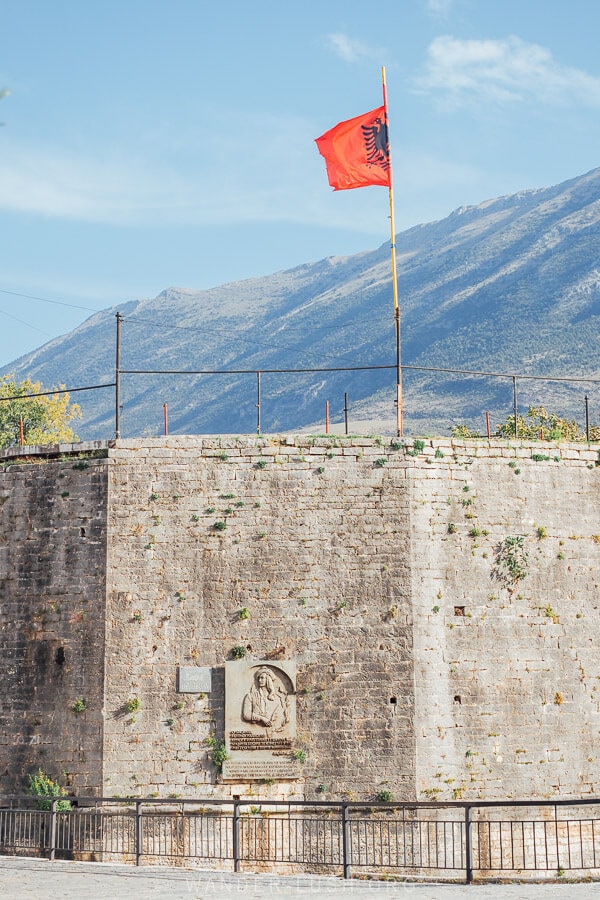
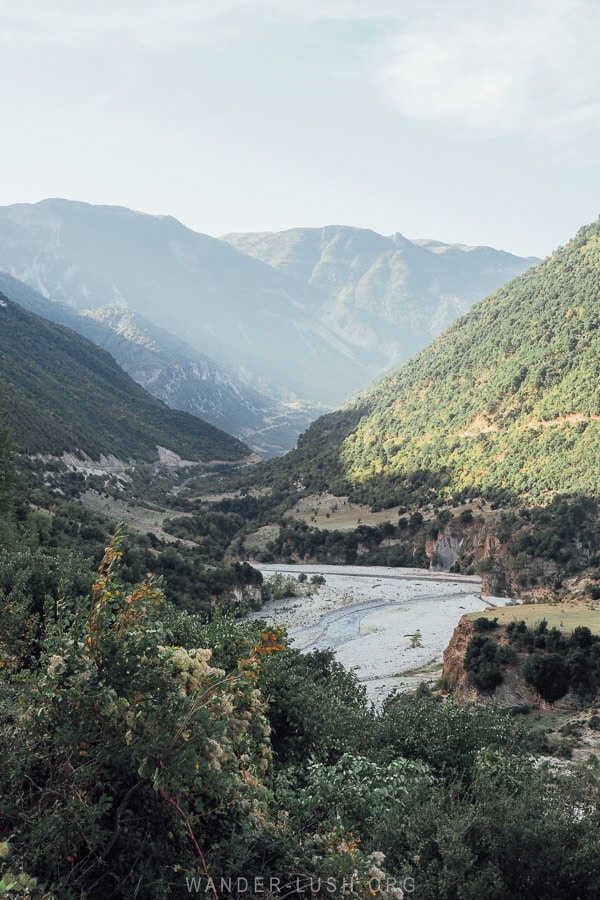
Tepelena has a dark past as the site of an internment camp where an estimated 3,000 people were imprisoned during the communist era, around 500 of whom never saw freedom again. There are plans to turn this camp and the notorious Spac Prison into museums; for now the site remains partially abandoned. I got the chills just seeing it from afar and did not want to go any further.
Ali Pasha’s Aqueduct is a short 10-minute detour from Tepelena via a scenic mountain road and was one of my favourite road stops. An incredible feat of Ottoman engineering, it was still used to irrigate fields up until a few years ago. The aqueduct has been partially reconstructed and a walking path built to access it from the highway. If you have time, a new marked hiking trail starts from behind the aqueduct.
We spent a good half hour photographing the aqueduct from different angles as the sun started to peek above the mountains, casting awesome shadows. Knowing we had a hike of sorts coming up later that day, we continued down to Permet (60 mins) and checked into our first hotel.
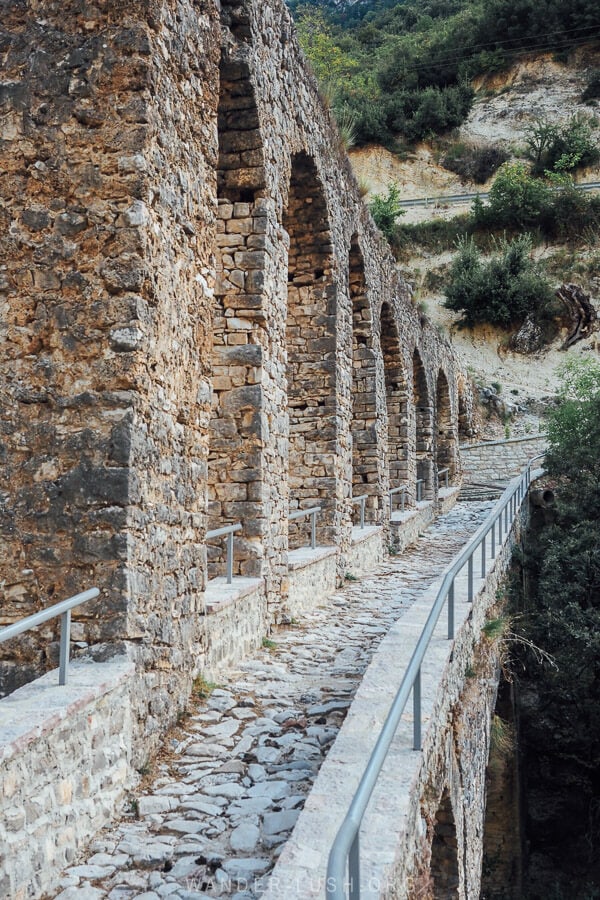
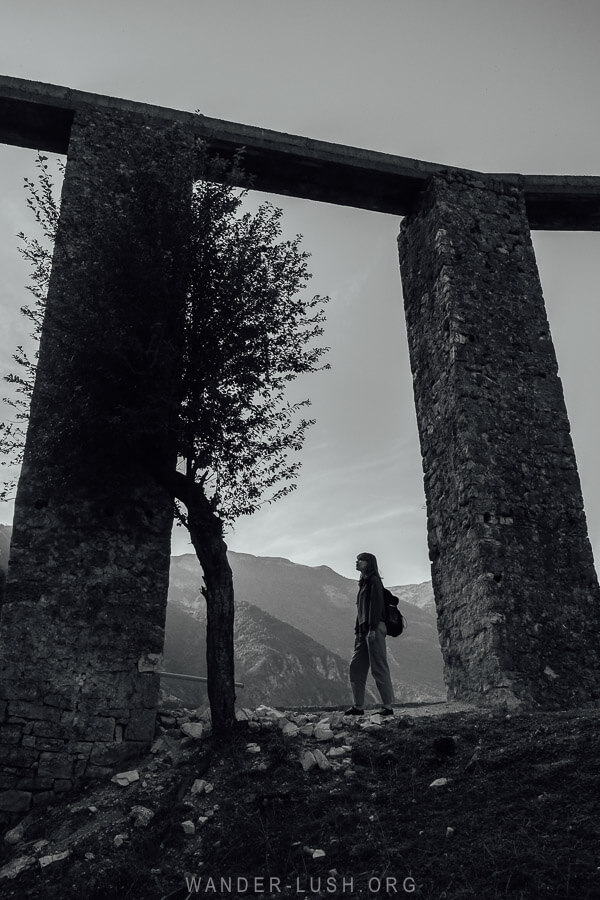
In the afternoon we embarked on the hike from Permet to Leus, a small village above the town. It’s only a 30-minute walk, but the steep incline and rough terrain makes it feel a lot longer.
When we arrived, we were elated to find a group of Chinese tourists and their guide, who was weidling a giant key, gathered in front of Leus Orthodox Church. It meant that our slog up wasn’t in vain – we were going to be able to see the interior. Painted from the rafters to the floor, with inlay wood ceilings and a mezzanine level you can climb to get closer to the dome, this is by far the most beautiful church I have seen in my life. I am not a particularly religious person, but it was nothing short of a transcendental experience.
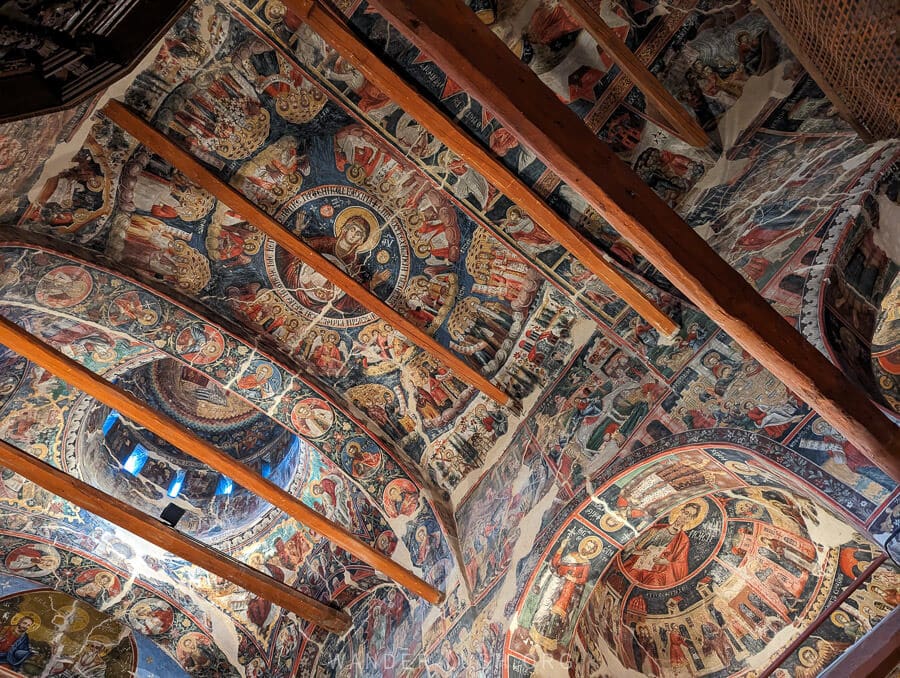
Still buzzing from our holy encounter, we spent another half hour wandering around Leus between haystacks and sweet cottages.
As wonderful as Villa Permet was, my biggest regret of the trip was not booking a night at Chri Chri Guest House in Leus (I tried, but they were sold out). It would have been wonderful to stay overnight in the tiny village, and I bet the owner can organise a visit to the church. Transfers are available from Permet for those who don’t have a 4WD.
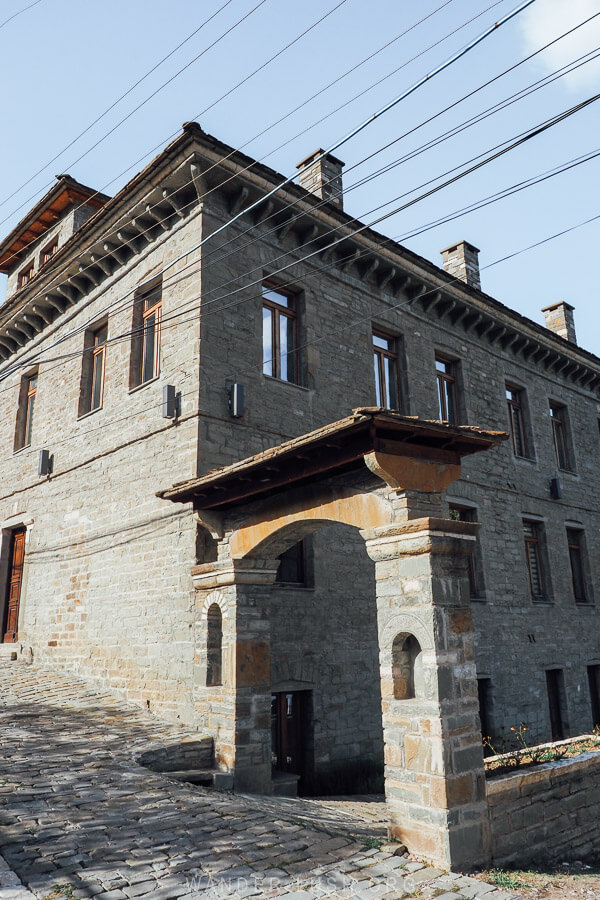
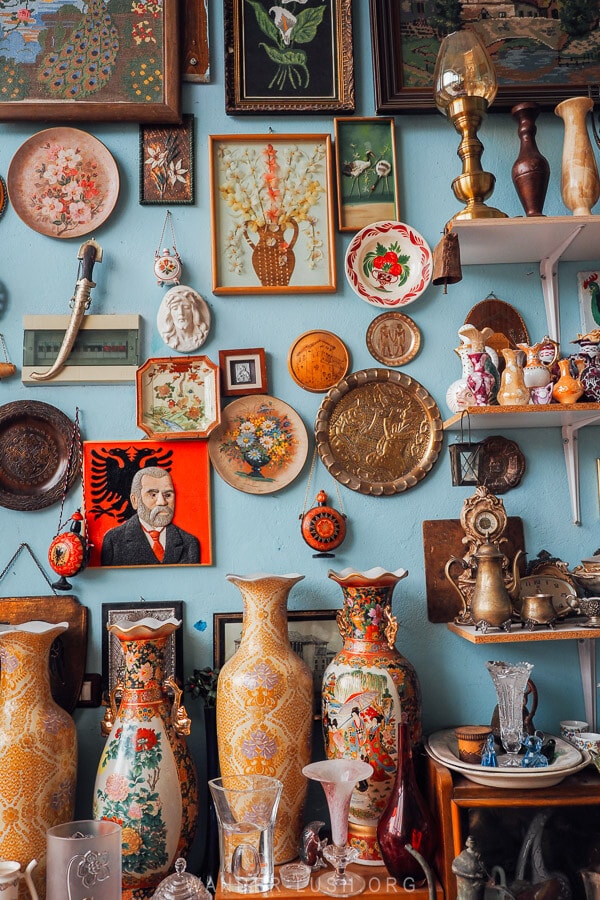
Stop — Ujë Ftoht Cafe; Tepelena Castle; Ali Pasha’s Aqueduct.
Park — Free street parking is easy to find in Permet.
Do — Breakfast at Ujë Ftoht Cafe; walk through Tepelena Castle; visit Ali Pasha’s Aqueduct; hike to the Orthodox Church of Leus from Permet.
Stay — Villa Permet or Guest House Shtepia ime in Permet or Chri Chri Guest House in Leus (night 1/2).
Day 9: Full day in Permet + Benja Thermal Springs
- Distance covered today: 14 kilometres (7 miles)
- Time in the car today: Approx. 60 minutes
- Recommended route: SH75 > Benja Road
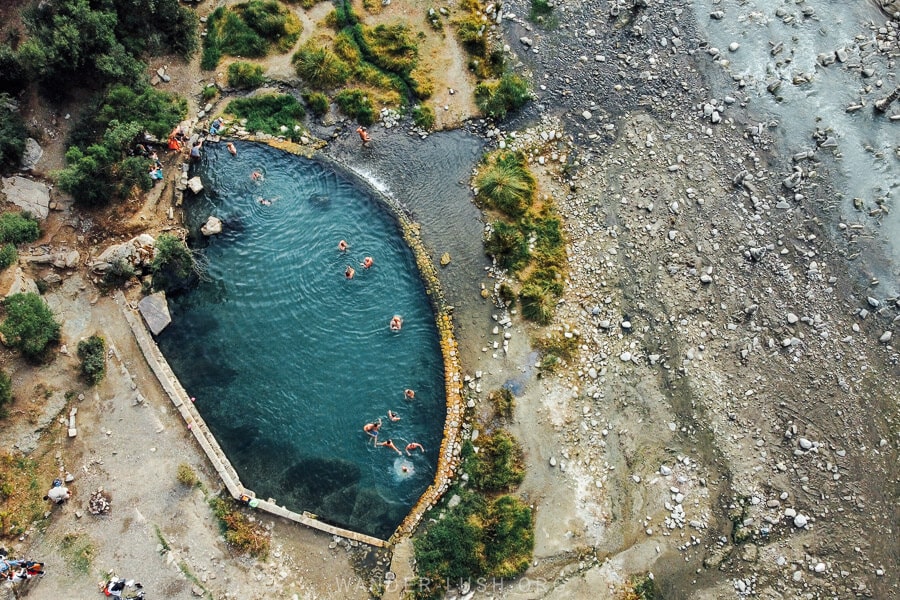
If it’s the season, then you could spend a day mountain biking on one of the newly marked trails around Permet or rafting on the Vjosa River. There is an information booth in the centre of town where you can hire bikes and inquire about river expeditions.
We didn’t have the best weather, so we spent the morning wandering the flagstone paths through Permet Old Town, browsing the cute antique shops – and most importantly, eating local cuisine. Of the half a dozen Slow Food restaurants in Permet that we managed to fit in, Bar Restaurant Trifilia was my favourite.
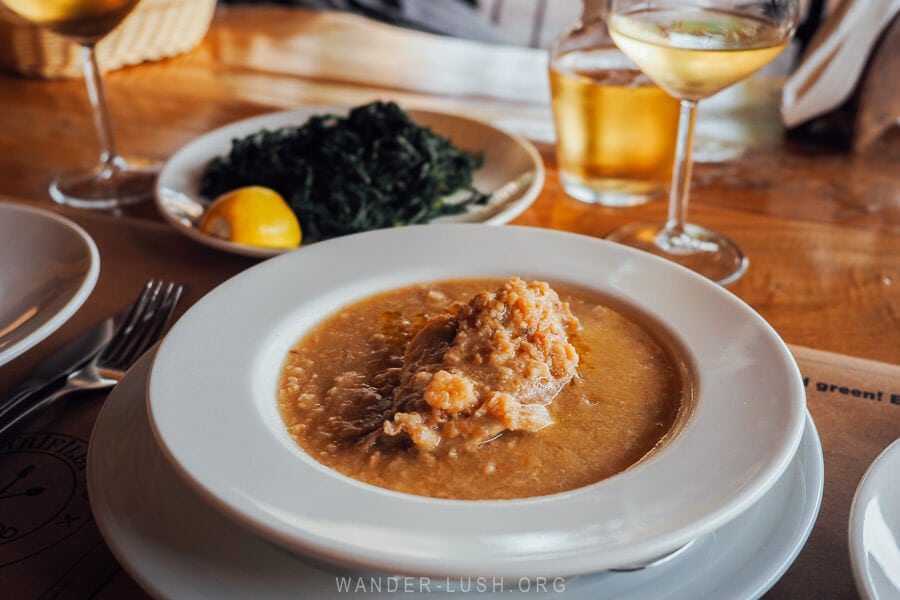
The drizzle had cleared by the afternoon so we made our way to the Benja Thermal Springs, a 30-minute drive away on the fringe of Fir of Hotova National Park. Set in the spectacular Langarica Canyon beneath the arched Ottoman-era Kadiut Bridge, there are seven separate pools fed by different mineral waters. It was reasonably crowded on an October afternoon, but I still enjoyed the experience. More secluded swimming spots can be found by trekking deeper into the canyon via the riverbank – but alas, we didn’t have the right footwear.
In the evening, we scaled the staircase to the top of Guri i Qytetit, a giant rock dropped in the centre of Permet, ahead of a satisfying dinner and glass of house wine at Te Culi Slow Food.
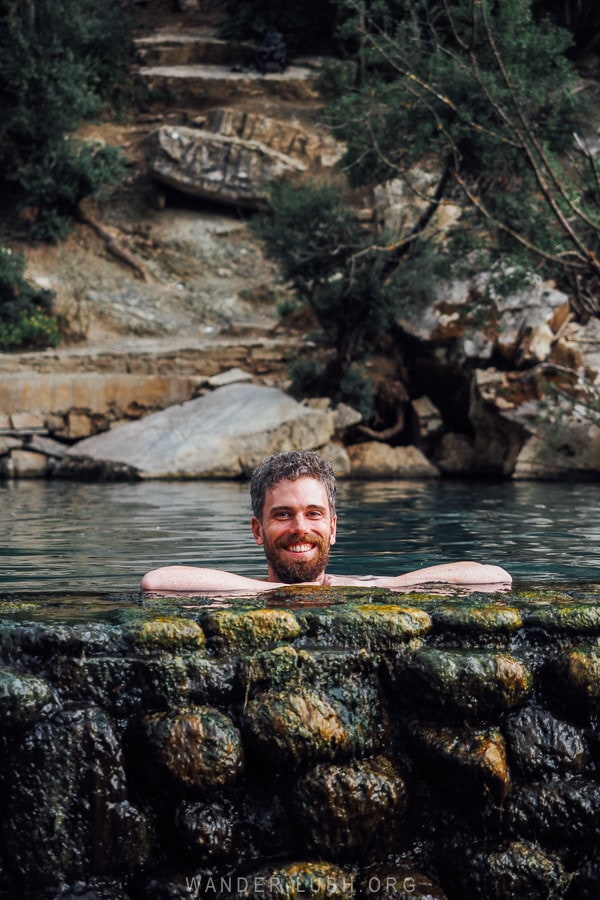
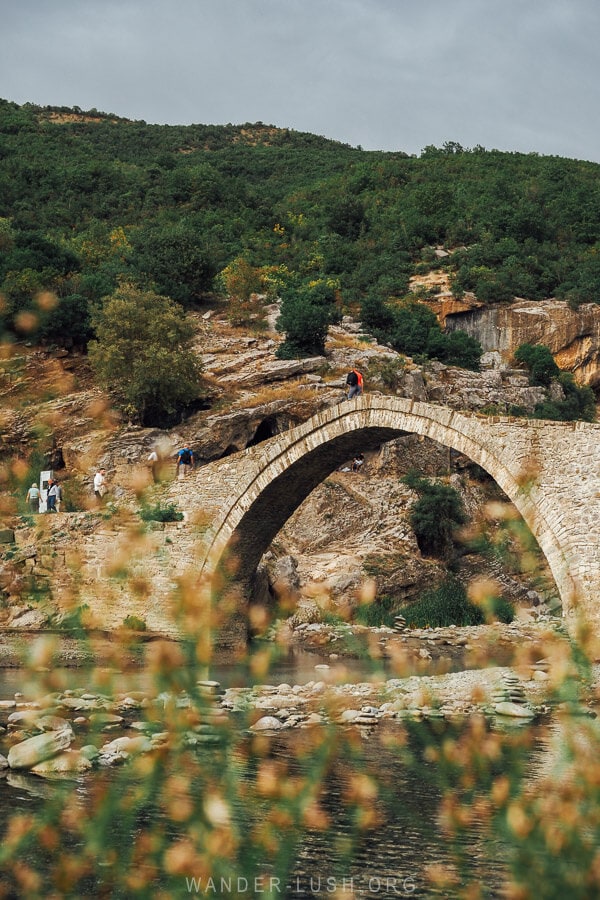
Do — Soak in the Benja Thermal Springs & hike through the gorge; explore Permet town; eat at Permet’s Slow Food restaurants.
Stay — Villa Permet or Guest House Shtepia ime in Permet or Chri Chri Guest House in Leus (night 2/2).
Further reading — My guide to Permet (coming soon).
Day 10: Permet to Leskovik
- Distance covered today: 54 kilometres (34 miles)
- Time in the car today: Approx. 2.5 hours
- Recommended route: SH75 > SH80 > backroad to Sarandaporo > SH65
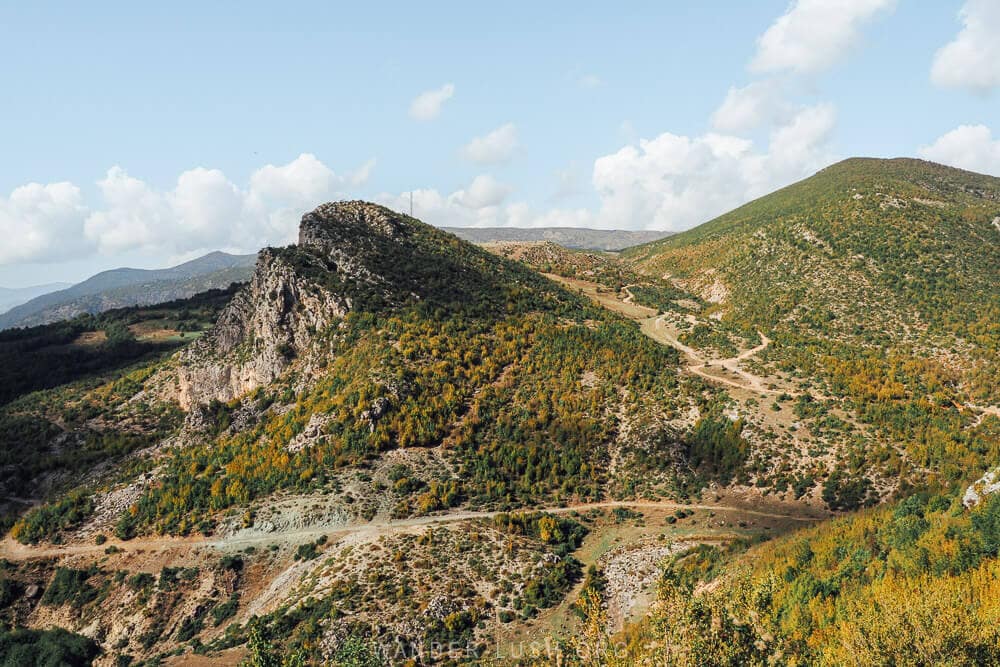
Today’s drive was the most anticipated of the trip – but of course we woke up to torrential rain. The clouds petered out as the day went on, but a heavy fog followed us all the way to Leskovik. I still managed to snap a few photos of the Vjosa River Bend (30 mins) and of an abandoned bridge wrapped in fall foliage.
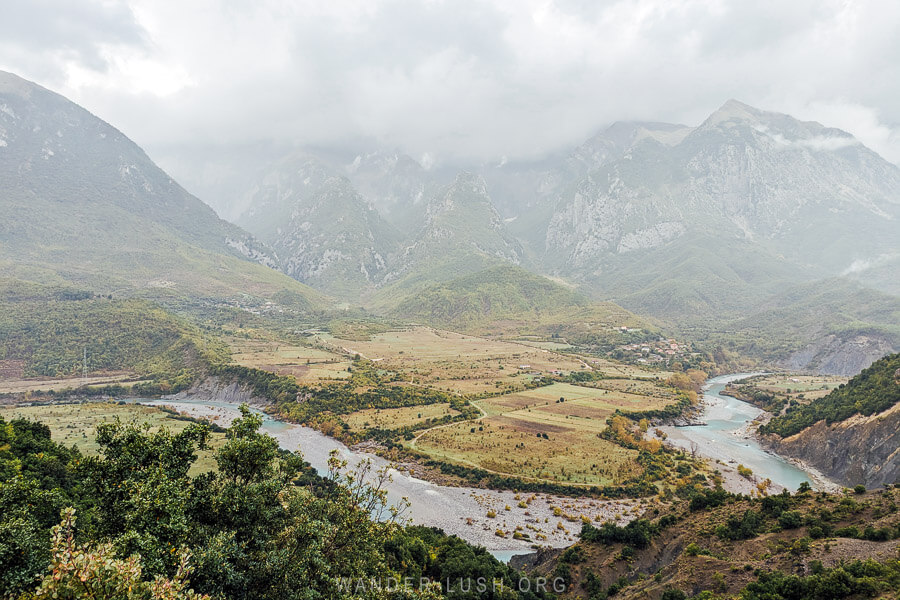
This time last year, Leskovik was not at all on the tourist trail. The tiny town in one of Albania’s most prestigious wine regions is still a bit of an obscure choice – the main reason we picked it was to break up the longest drive of the trip from Permet to Korca.
As it turned out, Leskovik is a very interesting place. When Enver Hoxha was in charge, Mavrud wines and raki from Leskovik were earmarked exclusively for him and the party elite. The mineral-rich soils here yield spectacular grapes, and even though the wine industry is a fraction of the size it once was, you can still see vast vineyards wrapped around the imposing limestone massif as you wind your way into the town.
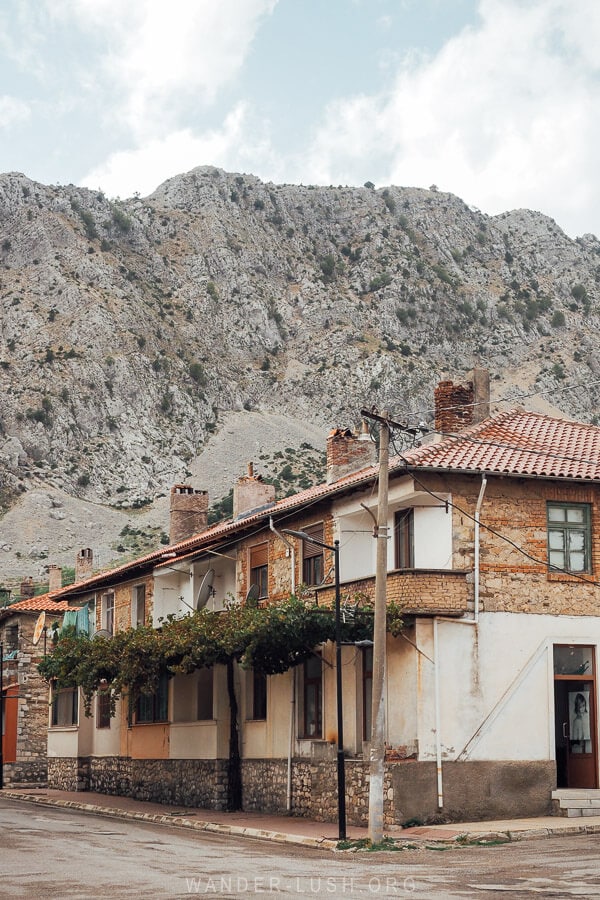
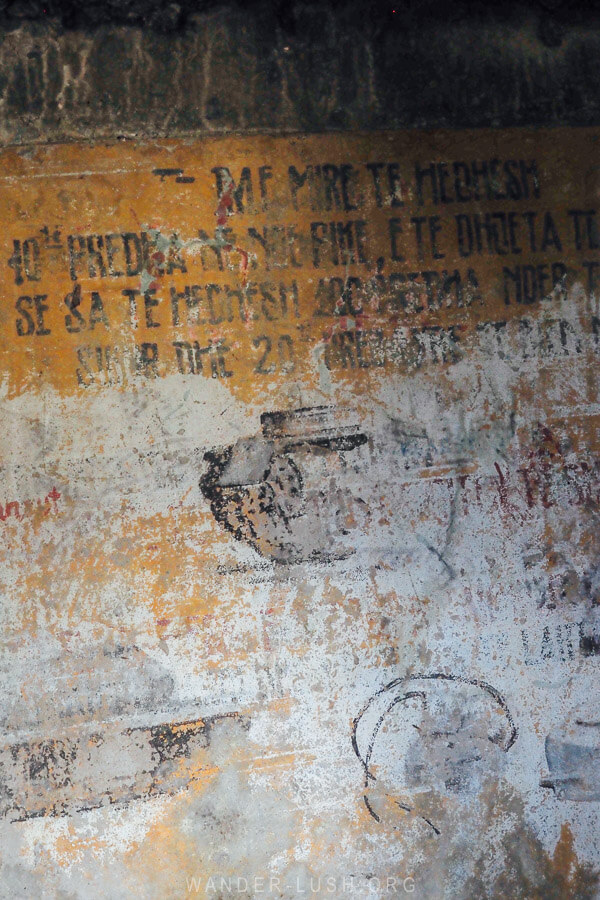
Named after that rock, Melesin Distillery is a new boutique hotel that is putting Leskovik back on the map. We splurged on a night here and didn’t regret it one bit – it was the best accommodation of our trip. The restaurant is top notch, serving local dishes alongside Leskovik wine and gin distilled in-house.
We spent the afternoon exploring Leskovik and made a brilliant ‘discovery’ when we stumbled on a set of bunkers with military diagrams painted on the walls. The town is very small and can be covered on foot in the space of an hour.
If the weather is on your side, then I suggest stopping at the Sarandaporo Thermal Springs on the way into Leskovik. (We backtracked to the springs the following morning.) A local alternative to Benja, Sarandaporo is located right on the Greek border. At one point we inadvertently wandered across the state line. Whoops.
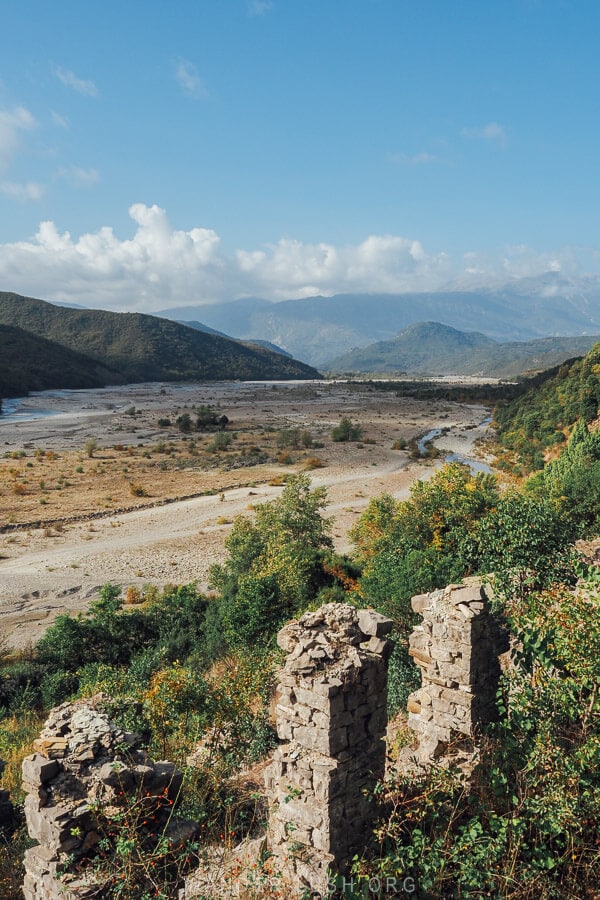
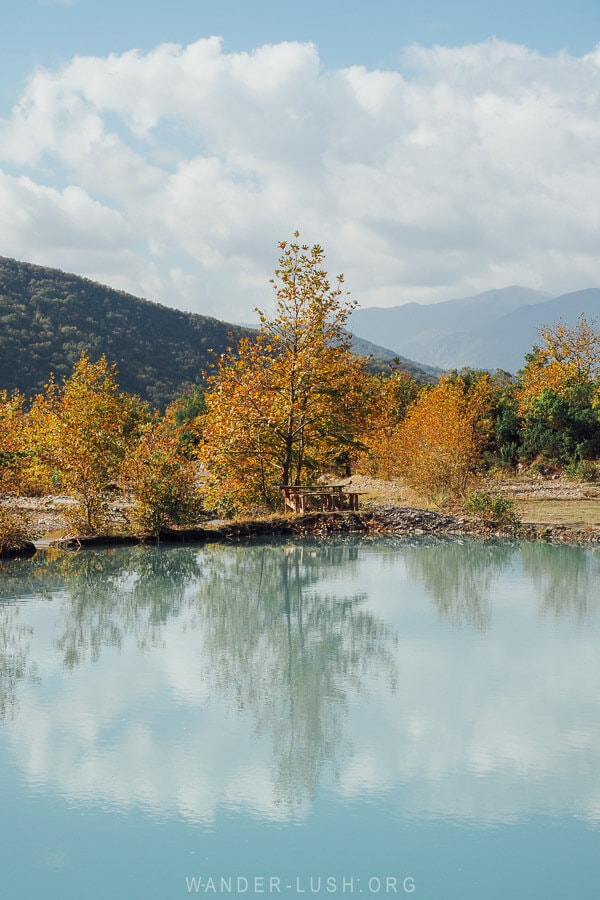
Crafted from stone blocks, the baths sit high above the river and are fed with bubbling sulfuric waters. The location is nothing short of spectacular. We were concerned about the road, but it turns out a freshly sealed road has been installed – part of the way, at least. We had to drive for around 10 minutes over gravel then walk another 30 minutes along the riverbed to find the springs. It was certainly an adventure.
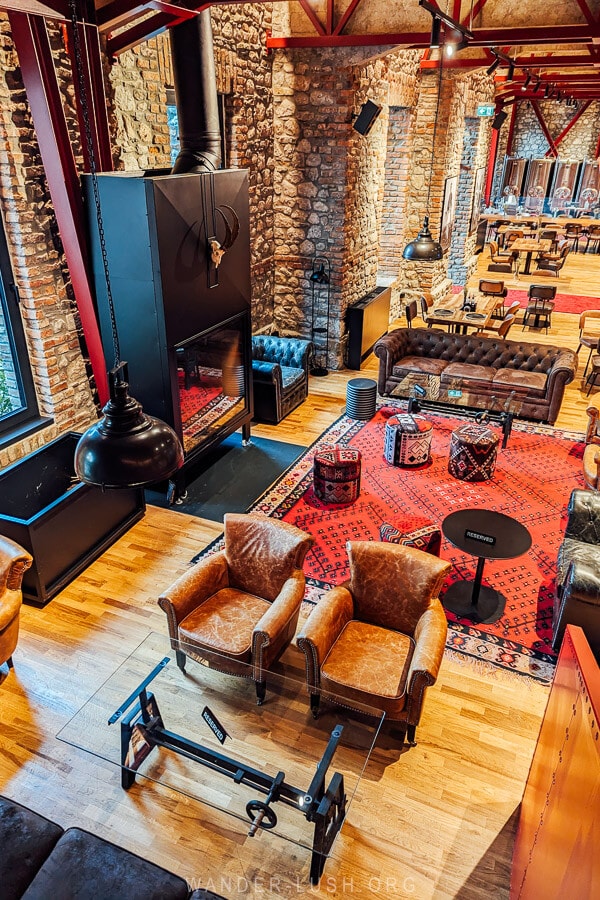
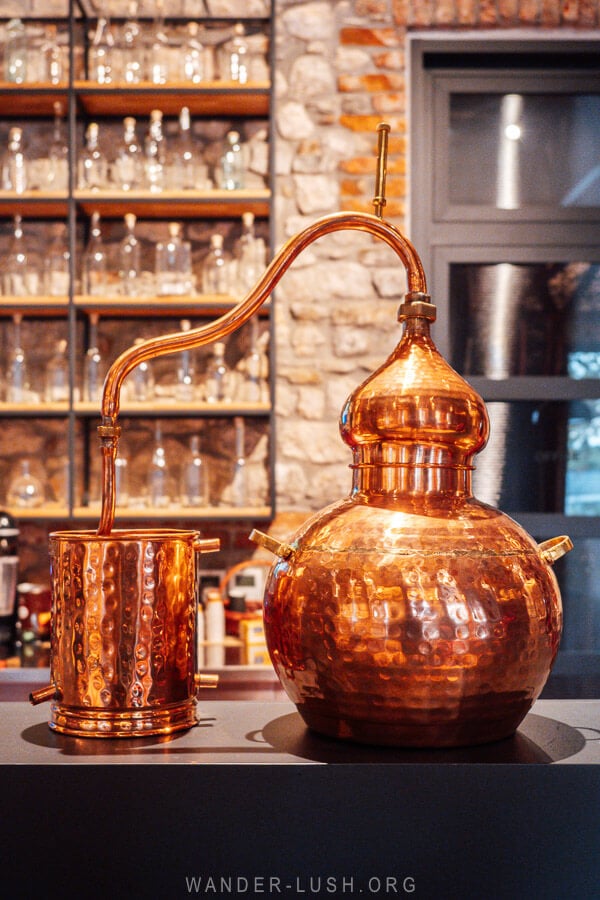
Stop — Vjosa River Bend Viewpoint; abandoned bridge; Sarandaporo Thermal Springs.
Park — Free parking is available in front of Melesin Distillery.
Do — Stop for photos of the Vjosa river bend & abandoned bridge; swim in the Sarandaporo Thermal Springs; gin tasting & dinner at Melesin Distillery.
Stay — Melesin Distillery.
Further reading — My guide to Leskovik.
Day 11: Leskovik to Korca/Voskopoja
- Distance covered today: 85 kilometres (53 miles) (or 105 kilometres to Voskopoja)
- Time in the car today: Approx. 3.5 hours (or 4 hours to Voskopoja)
- Recommended route: SH75
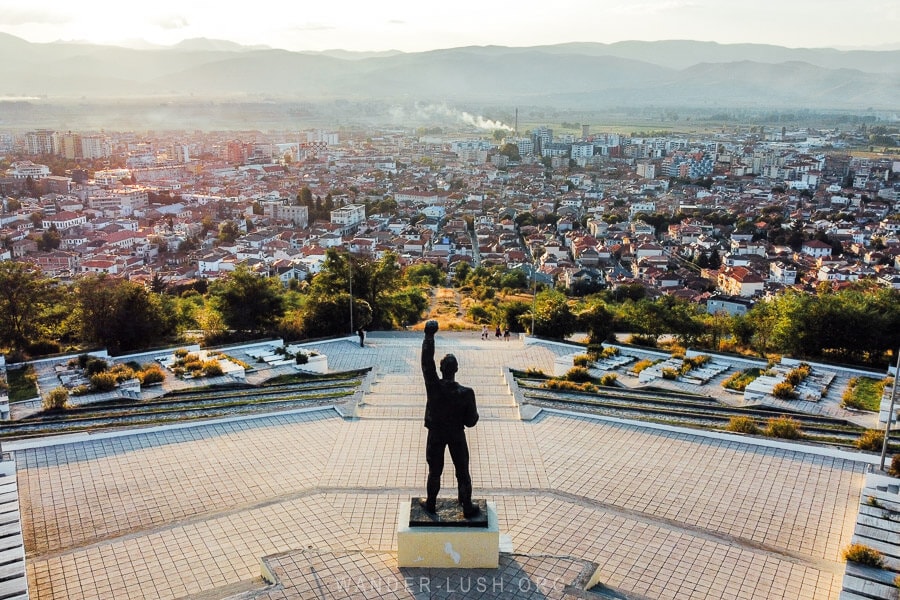
Day 11 was the longest drive of the trip, mostly because of the road conditions. Construction on this highway has been ongoing since summer. Once complete, it will shorten the drive time considerably.
As it currently stands, the worst section of road is around Barmash. Mostly compacted gravel, it’s far from the worst road I’ve seen, but it is bumpy and slow going. After Erseke, it is all smooth sailing over a freshly tarred highway.
Unsure of just how long the drive to Korca would take, we were very selective with our stops and only made quick photo breaks in Barmash and Erseke for the war memorials. We planned to visit the Kamenica Tumulus Archaeological Museum, but like most museums in Albania, it was closed on a Monday.
Unperturbed and grateful to be nearing our destination well before sunset, we continued to Voskopoja, a small village 30 minutes outside of Korca.
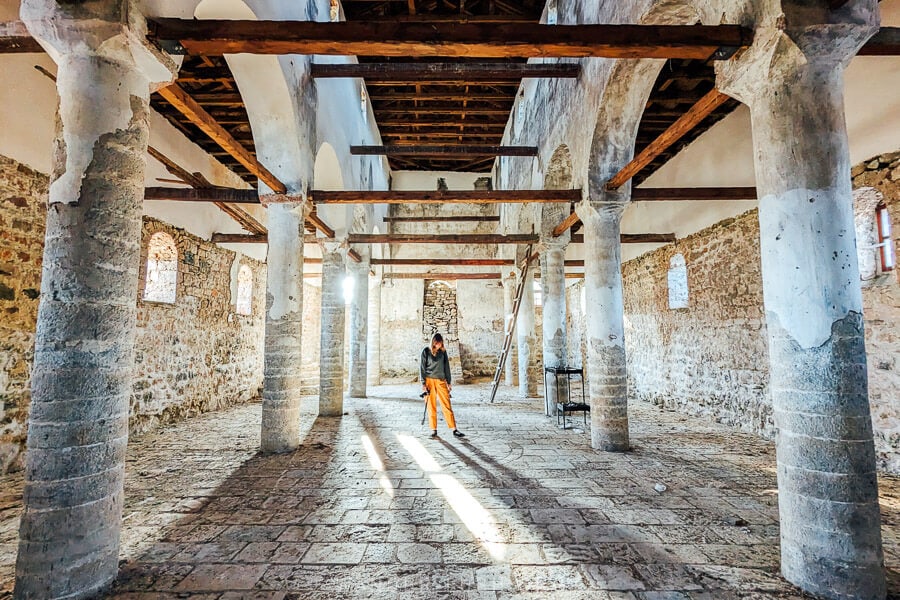
Voskopoja is famed for its high concentration of Orthodox churches that date back to the 18th century when it was one of the biggest cities in the Balkans and a centre of Aromanian culture. We only managed to see two of the half a dozen churches we had bookmarked – the rest were closed for restoration and covered in scaffolding (please do take this into consideration when planning a trip; works are not expected to be completed before summer 2024). Of course there was no information anywhere online about the closures.
We did manage to get inside the 1751 Profet Ilia Monastery, which almost redeemed Voskopoja with its sunset magical-ness.
Overall though, Voskopoja was a let down – not only because of the churches being closed, but also because the whole place had a slightly off-putting, almost fake feel to it. After visiting so many lovely villages earlier in the trip, Voskopoja just didn’t do it for me.
I recommend staying in Korca for two nights and potentially adding a half-day trip to the village if you’re desperate to see the churches.
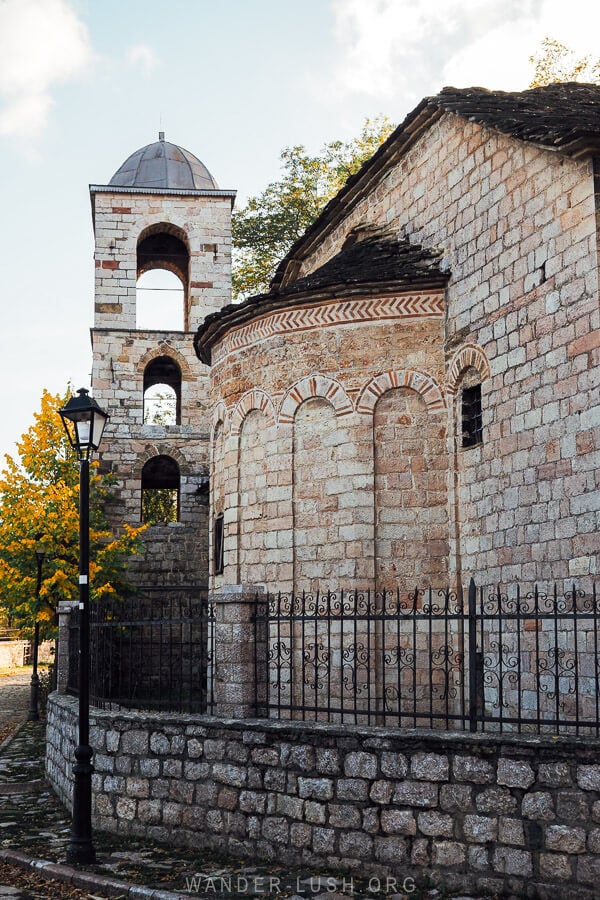
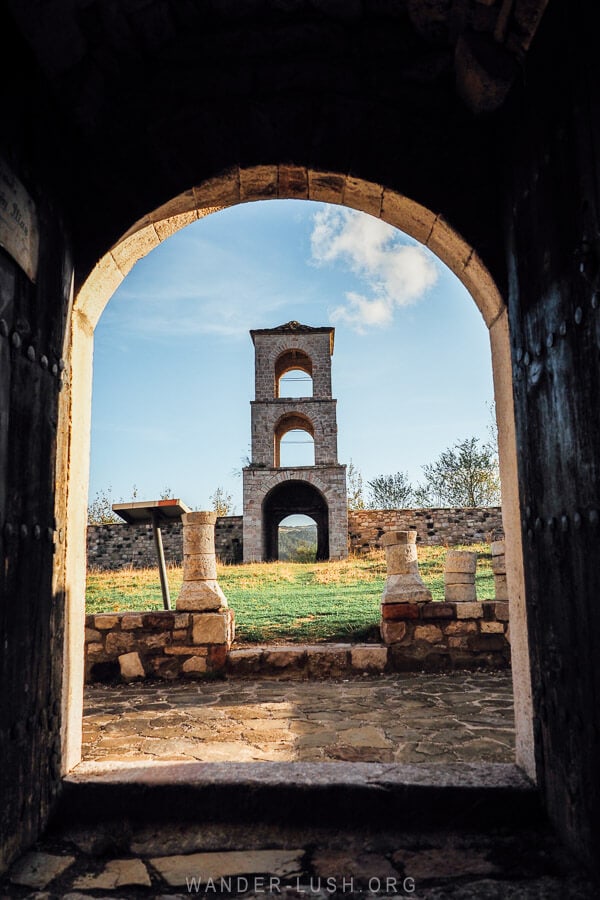
Stop — Various WWII memorials; Kamenica Tumulus Archaeological Museum.
Park — In Voskopoja, park at your guesthouse or on the street. In Korca, you must pay to park in the city centre (find a spot, and an attendant will come and find you to exchange cash for a paper ticket that you should display on your windshield).
Do — Kamenica Tumulus Archaeological Museum (optional); Voskopoja (if staying in Korca).
Stay — Villa Domenico (Korca) or Stone Villas (Voskopoja).
Day 12: Full day in Korca
Less than 40 kilometres from the border with Greece, Korca is completely unique among Albania’s cities. Long a stronghold of education and culture, it has its own unique character and – not surprisingly – a strong Greek vibe.
This was our third visit to Korca. We first came here back in 2019 on our way overland to Thessaloniki, and on this trip, we entered Albania via Korca in a taxi from Kastoria.
Between the restored Old Bazaar and the many excellent museums, Korca has enough points of interest for one day. Don’t miss the National Museum of Medieval Art or the Birra Korca Brewery, a delightful beer garden serving Albania’s oldest brew.
This time around we joined the Free Walking Tour of Korca. It is quite casual and fun, and for an introduction and orientation, it’s a good way to spend a couple of hours. Other highlights were eating lakror, a giant pie that is Korca’s specialty dish, at Shija e Saçit, hiking to the Martyrs Cemetery, Varrezat e Dëshmorëve, at sunset, and driving up to the Kryqi Moravë viewpoint just after sunrise.
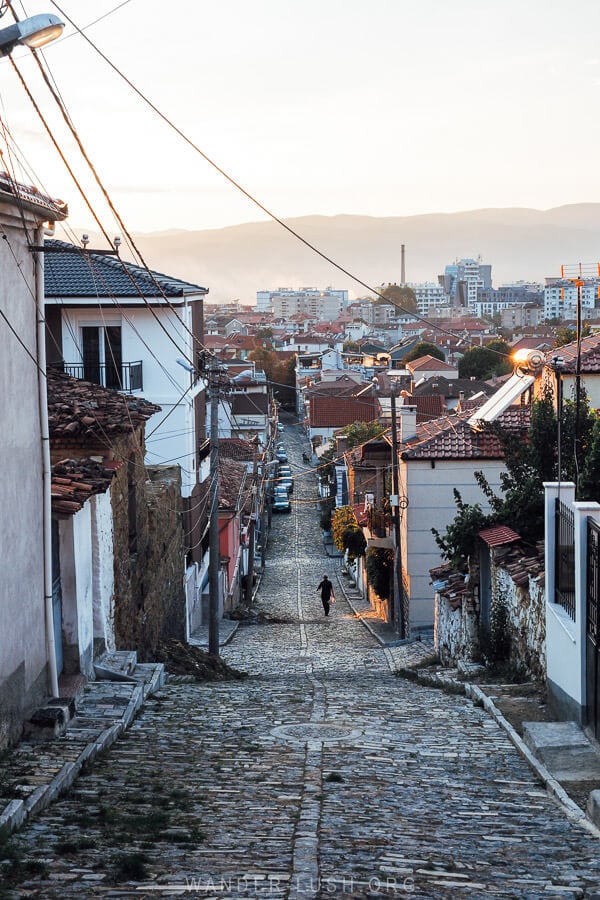
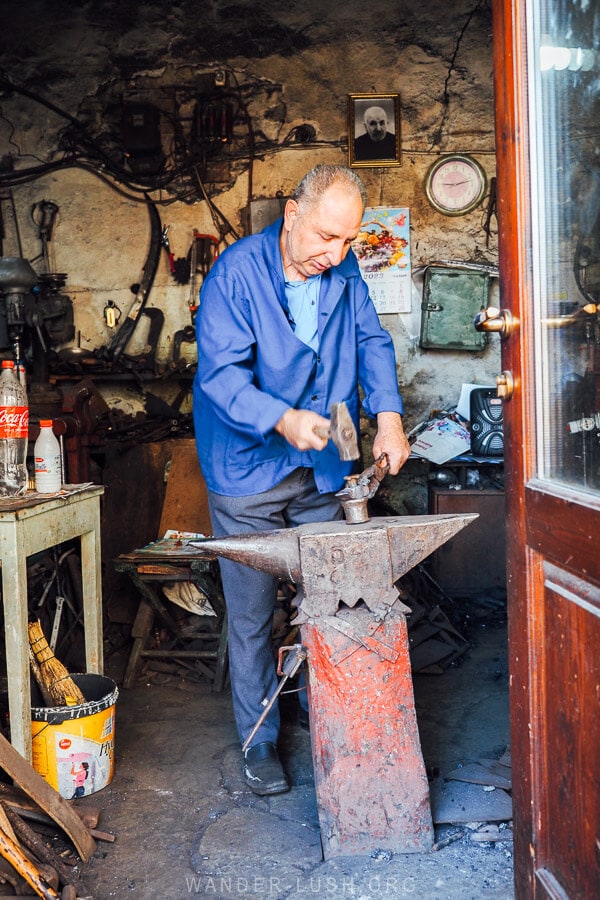
Do — Climb the Panoramic Tower; visit the National Museum of Medieval Art; walk in the old town & Old Bazaar; drive to the War Memorial & church viewpoint; beers at the Birra Korca brewery.
Stay — Villa Domenico.
Further reading — My Korca city guide.
Day 13: Korca to Lin (Lake Ohrid)
- Distance covered today: 107 kilometres (66 miles)
- Time in the car today: Approx. 3 hours
- Recommended route: SH3 via Sovjan
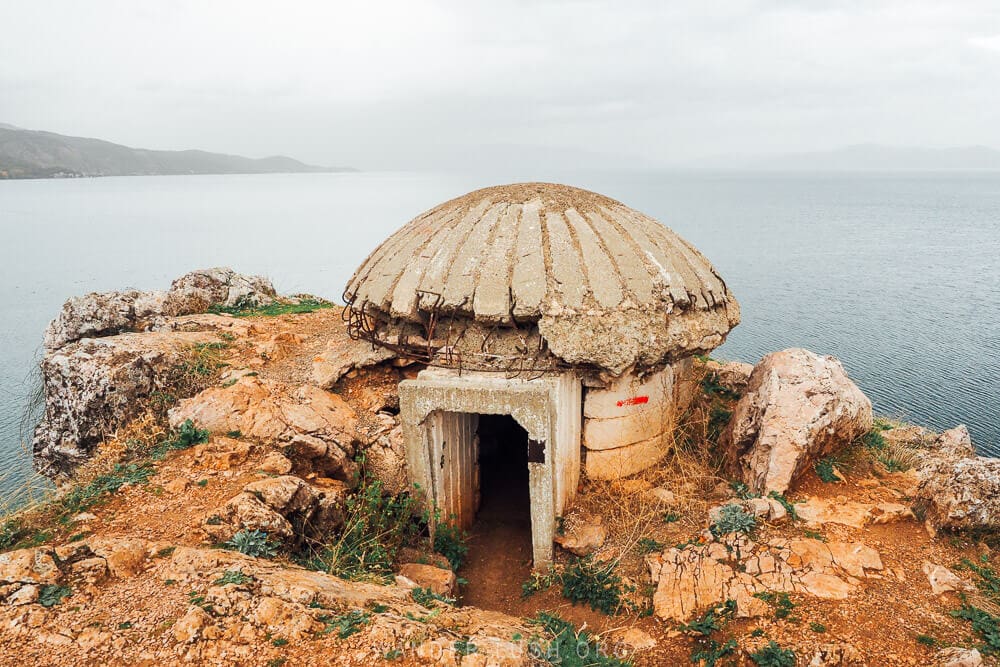
Having visited the North Macedonian side of Lake Ohrid (and the eponymous Ohrid) back in 2019, I was quite keen to see how the ‘other side’ of the lake compared. We ended up spending two nights in the area, staying in Pogradec (the biggest Albanian city on the lake) and in the cute village of Lin further north.
My conclusion: Albanian Ohrid is sparser and feels more threadbare. While you could happily spend a week in Ohrid city (like we did), Pogradec by comparison is small and a bit dated. You only need to spend one night on the lake – and it should definitely be in Lin.
Pogradec is a quick 50-minute drive from Korca via Sovjan. If you are so inclined, stop off to grab a coffee or breakfast, walk the waterfront promenade, and peek at the old houses in Toplec Quarter (around this point).
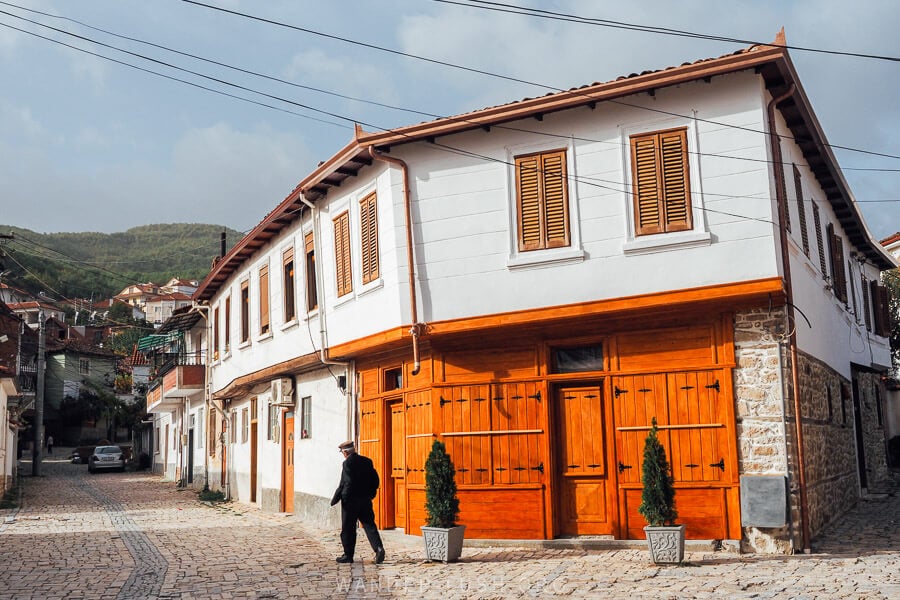
Another 20 minutes and you will reach Lin, which is everything Pogradec is not (sorry, Pogradec!). Now believed to be the oldest continuously inhabited village in Europe, it boasts Paleo Christian mosaics and Albania’s most photogenic bunker. Like Dhermi, Lin is another small village of cobbled streets and vernacular architecture that was made for wandering.
An hour or so away from Lin, the Royal Tombs of Selca date back to the days of the Illyrian Kingdom and were carved from the rocky terrain between the 4th and 1st centuries BC. Though not at all compulsory, the tombs are an adventure – and the rural location is quite spectacular. On the way, we stopped for the Ottoman-era Golikut Bridge, one of the loveliest stone bridges in Albania.
It is faster and easier to access the tombs from Lin (rather than Pogradec). Presently there are roadworks in this area, which makes it difficult to locate the correct road. Follow the sealed bitumen road as far as you can, past the bridge, turn left onto the new road, then continue along the concrete path.
Despite it being a tentative UNESCO Site, there is next to no signage for the tombs. We parked our car near the lone sign board then took a guess that the tombs would be located on top of the hill – we were right, thankfully. To find them, follow the concrete stairs to the top. The first few tombs are nice, but the most impressive ones are located around the corner.
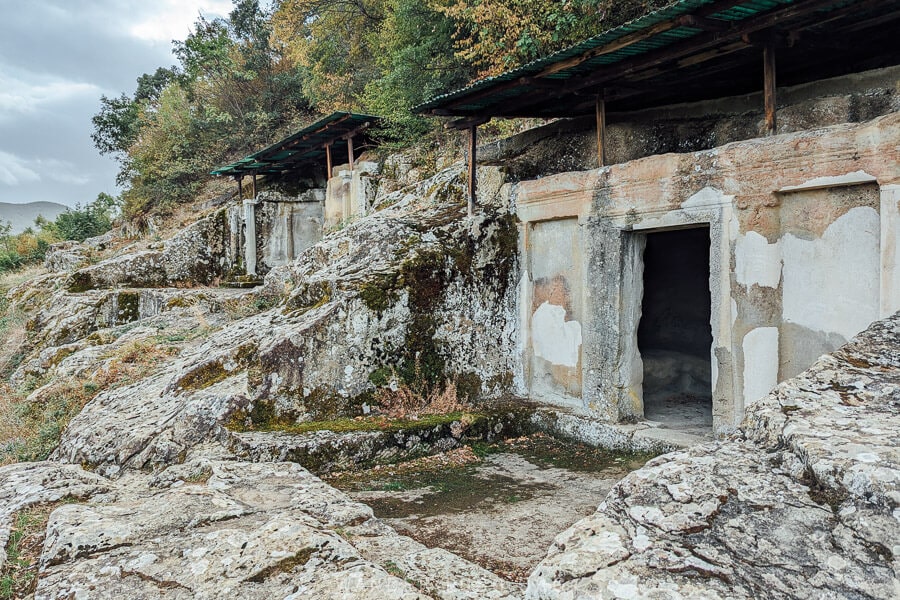
Back in Lin, we checked into our delightful room at House 1960, put in our dinner order, and explored the village on foot. The caretaker unveiled a corner of the Lin Mosaic for us (like in Butrint, it is covered in sand for posterity), then we hiked out onto the peninsula to see the bunker caught between the glassy lake and a stormy sky.
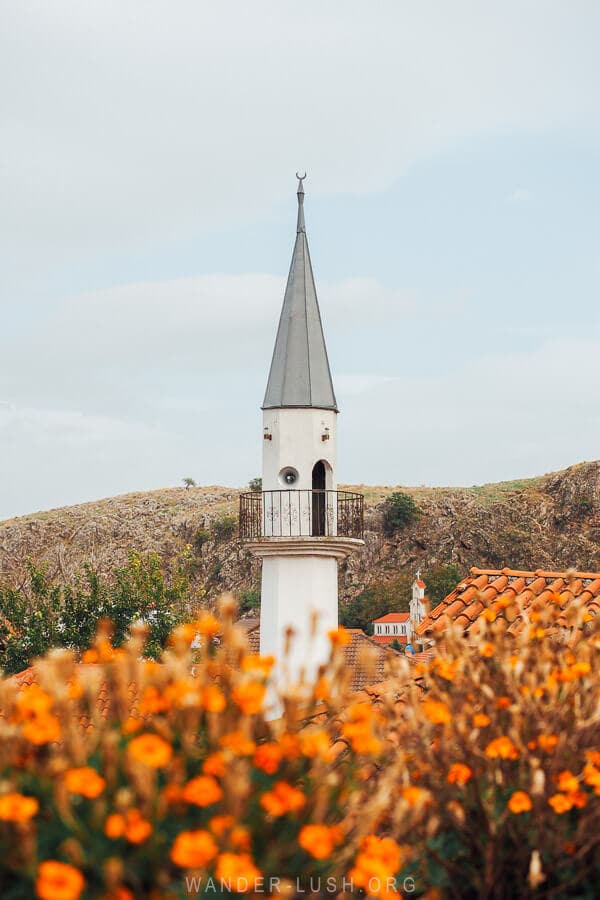
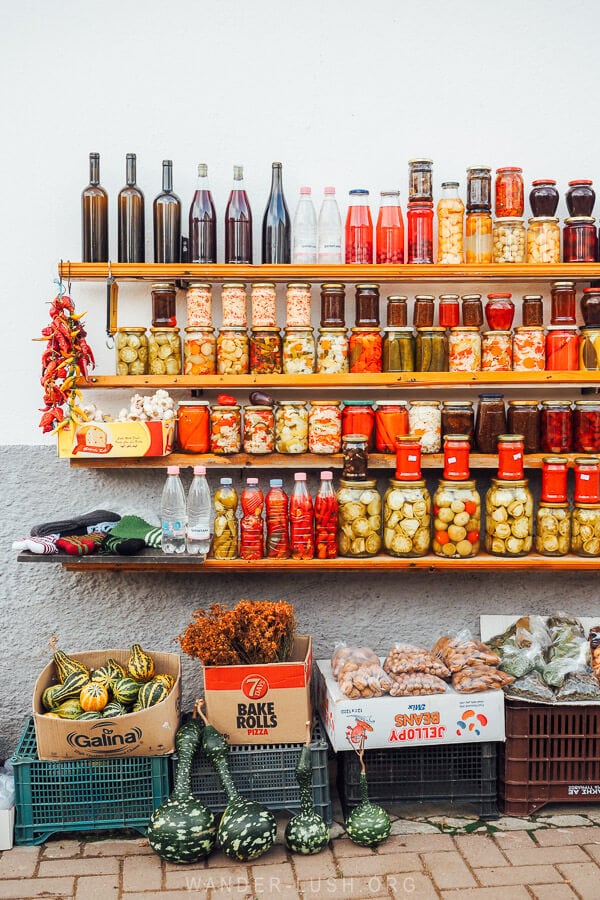
Stop — Pogradec; Golikut Bridge; the Royal Tombs of Selca.
Park — Lin village is tiny and parking is very difficult. House 1960 has a designated lot, but it only fits a couple of cars. Be sure to mention that you are driving so that hosts Merita and Emri can save you a spot.
Do — Stroll the waterfront in Pogradec & see the old town; stop at the Golikut Bridge; explore the Royal Tombs of Selca; peek at the Lin Mosaic; hike the peninsular for sunset from the Lin Bunker; fish dinner at House 1960.
Stay — House 1960.
Further reading — My full guide to visiting Lin.
Day 14: Return to Tirana
- Distance covered today: 106 kilometres (66 miles)
- Time in the car today: Approx. 2.5 hours
- Recommended route: SH3 via Elbasan
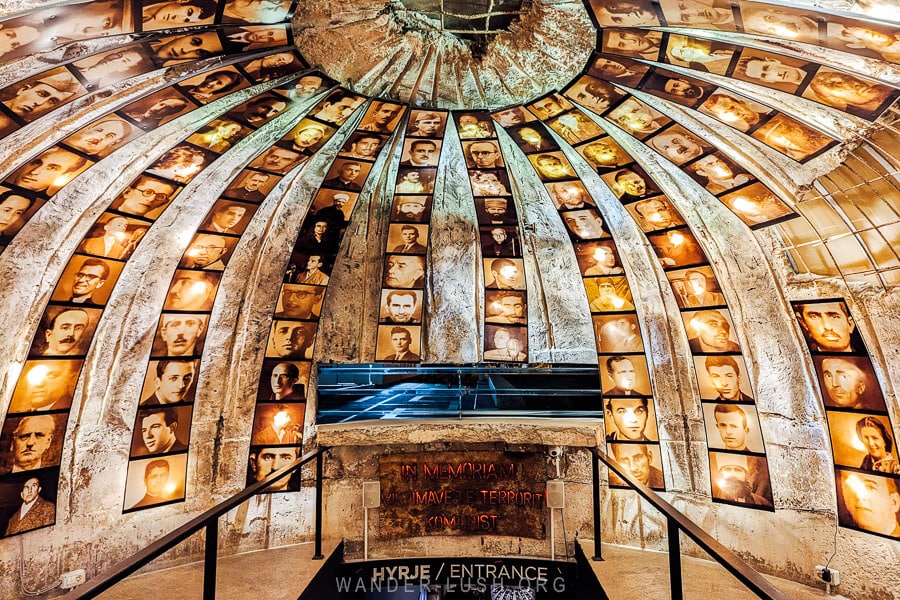
Waking up in Lin on the final morning of our road trip, we took one last walk down to the lakefront and greeted a trio of fishermen just as they were bringing in their haul. In under three hours we would be back in busy Tirana – so we savoured every last vignette of village life.
From Ohrid Lake, it is a straight shot along the highway back to Tirana via Elbasan. We had arranged to return our car in the late afternoon so we paced ourselves with a couple of stops here and there. The city of Elbasan (90 mins) looked interesting and I would have liked to have a proper walk around – maybe next time.
The road between Tirana and Lin follows the communist-era railroad that once connected all of Albania, but has long since been abandoned. Inspired by this guide, we stopped at the impressive Bushtrica Bridge and did a bit of urbexing at the abandoned train station in Xhyre. We also stopped in Perrenjas to photograph the industrial complex that has been decorated with ladybug murals.
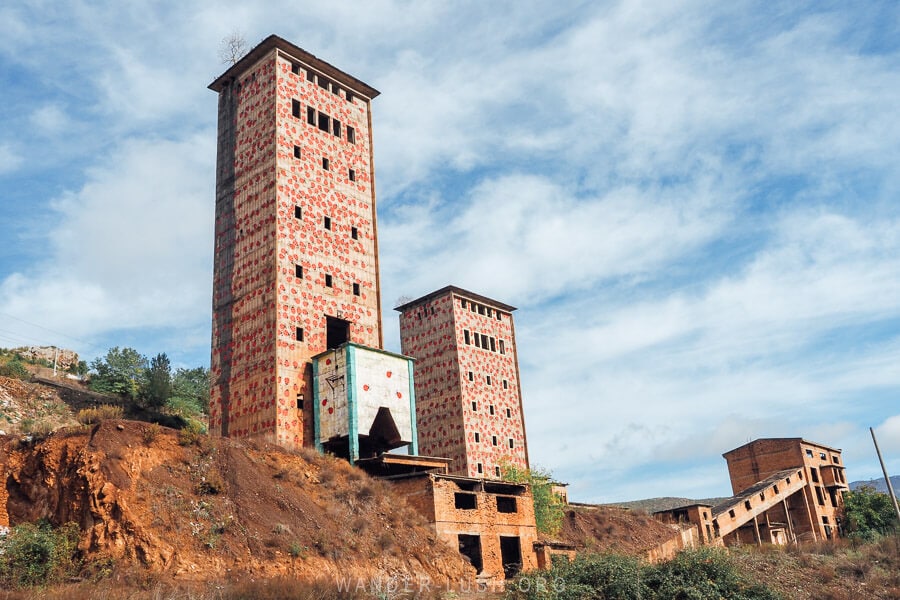
Google Maps routed us back into Tirana via the same highway we had left on. We knew exactly where to go to get back to the rental office. Returning the car took less than five minutes, then we jumped a bus back to the city centre. We had enough time for an afternoon walk in the city and dinner in Blloku before flying out the following afternoon back to Kutaisi.
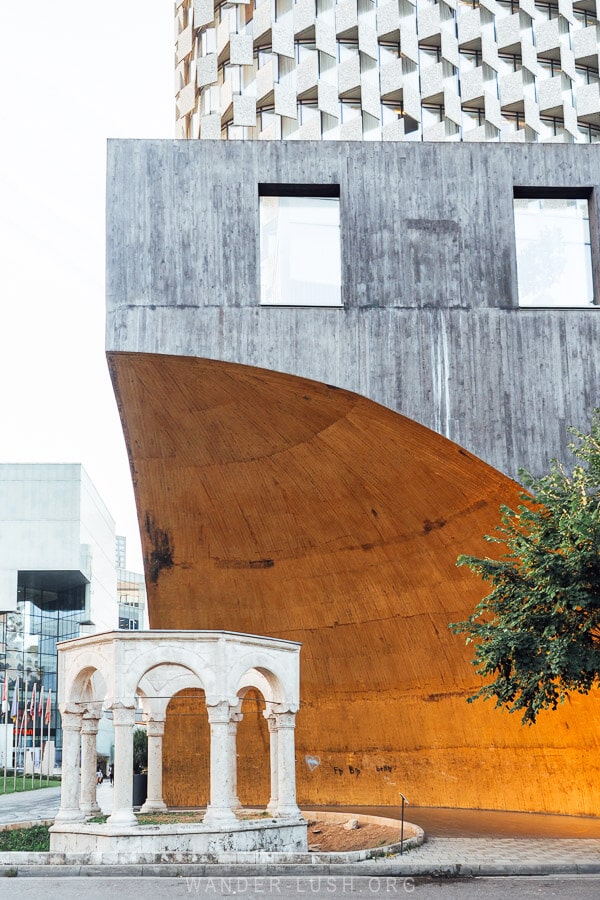
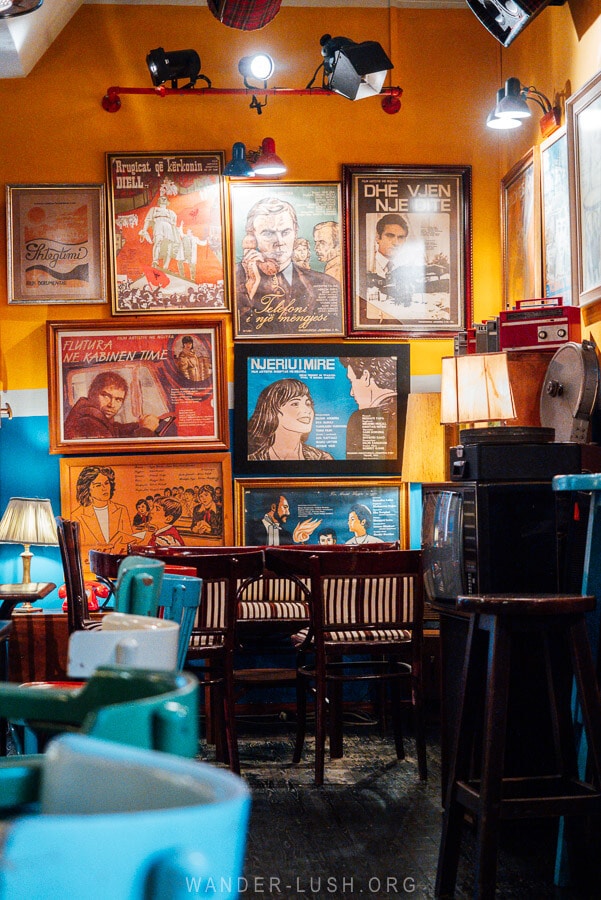
Stop — Lin viewpoint; Perrenjas street art; Xhyre abandoned railway station & bridge; Elbasan (optional).
Do — Early morning walk in Lin to greet the fishermen; stop at the Lin viewpoint; explore the abandoned train station and bridges around Xhyre; lunch in Elbasan (optional); return your car; afternoon walk in Tirana; dinner in Blloku.
Stay — Konak Skanderbeg Square is a self-contained apartment with a shared kitchen. We chose it because of its proximity to the square – it was easy to get to by bus from the rental car office, and easy to get away using the airport bus that also departs from the square (more information about getting back to Tirana Airport in this guide).
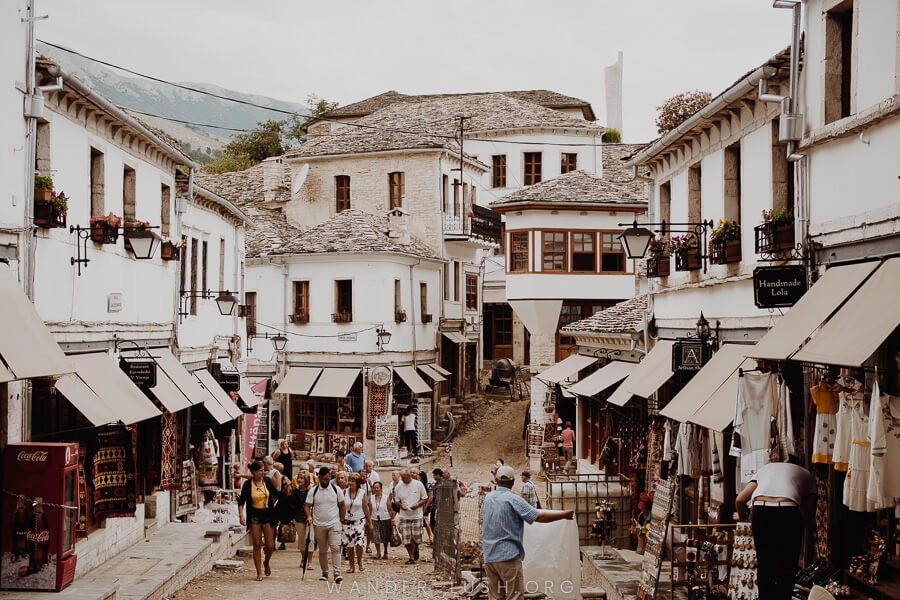
Albania Travel Guide
Discover insider tips, itinerary inspiration, and all the best things to see, do and experience in Albania!
Albania Essentials
My favourite resources and tools for planning a trip to Albania.
More from Albania
Albania Travel Guide
Discover insider tips, itinerary inspiration, and all the best things to see, do and experience in Albania!
